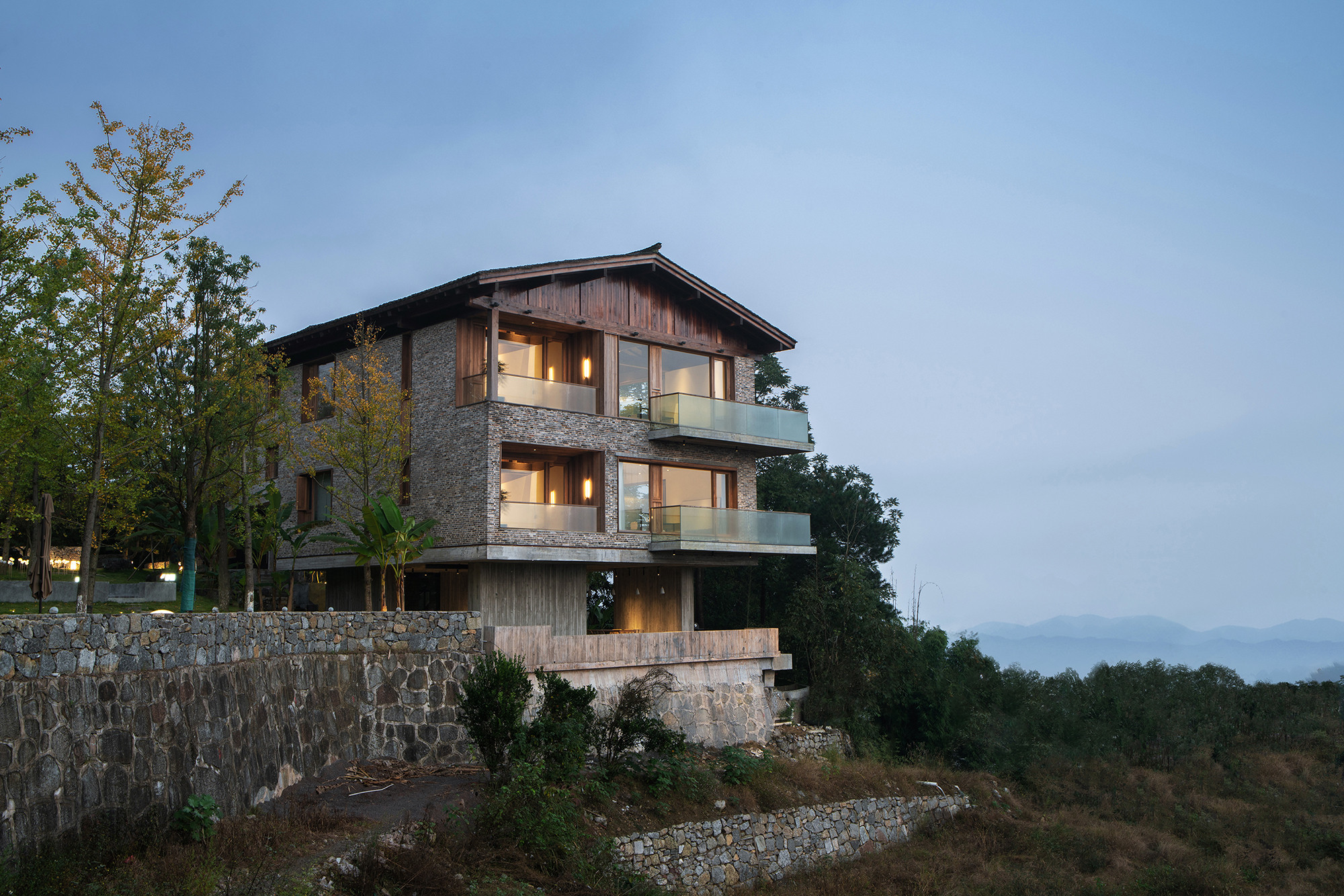
设计单位 尌林建筑设计事务所
项目地点 湖南张家界
建成时间 2020年8月
建筑面积 1200平方米
撰文 陈林
缘起
马儿山村离张家界主城区约25分钟车程,相较于张家界景区,这里的山虽不是奇峰却也林木葱茏,加上零星散落于山坡田野间的民居,别有一番野趣。场地上原有两个用来烧烤的木构亭子,被松树、苦莲子树、小竹林、银杏林包围。向北面远望,可见连续的山景,如卷轴般铺展在视野内。这般环境及氛围,成为了林语山房设计过程中最有力的依据。
Ma'er Shan village is 25 minutes’ drive from the major town area of Zhangjiajie. Compared to the astounding cliffs and valleys of Zhangjiajie scenic area, the mountains in Ma'er Shan village are not as exquisite yet still inherit a strong scent of rural joys through its lush green environment and scattering country houses. The site used to possess two wood-structured barbecue pavilions surrounded by pines, China-berry trees, ginkgo trees, and a bamboo copse. Gazing towards the north, the visitor will receive an expansive vision of continuous mountains, as seeing a panoramic landscape painting unfolding itself. The environment and the atmosphere thoroughly inspired us during the design of Woodsy Whisper residence.
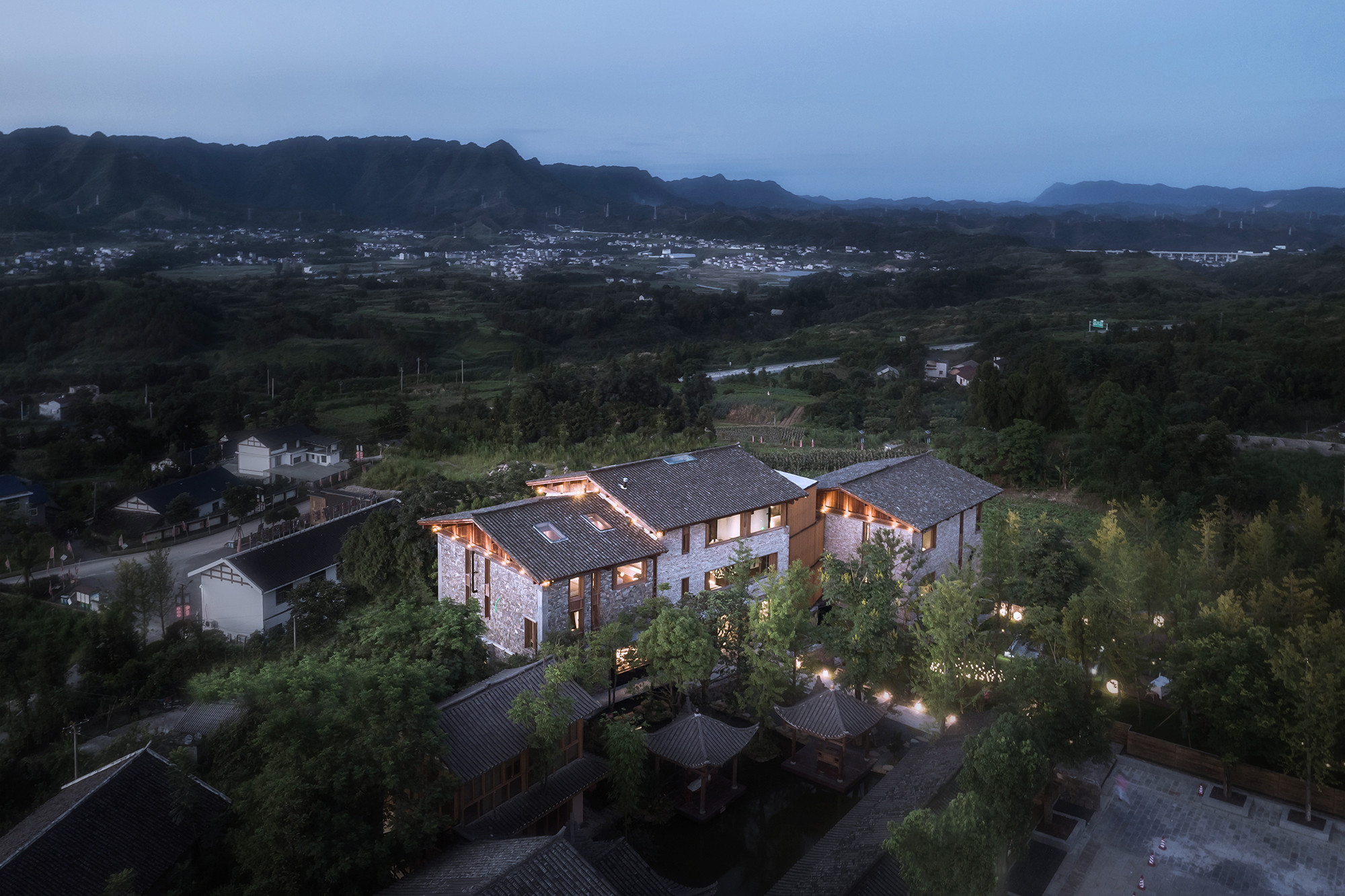
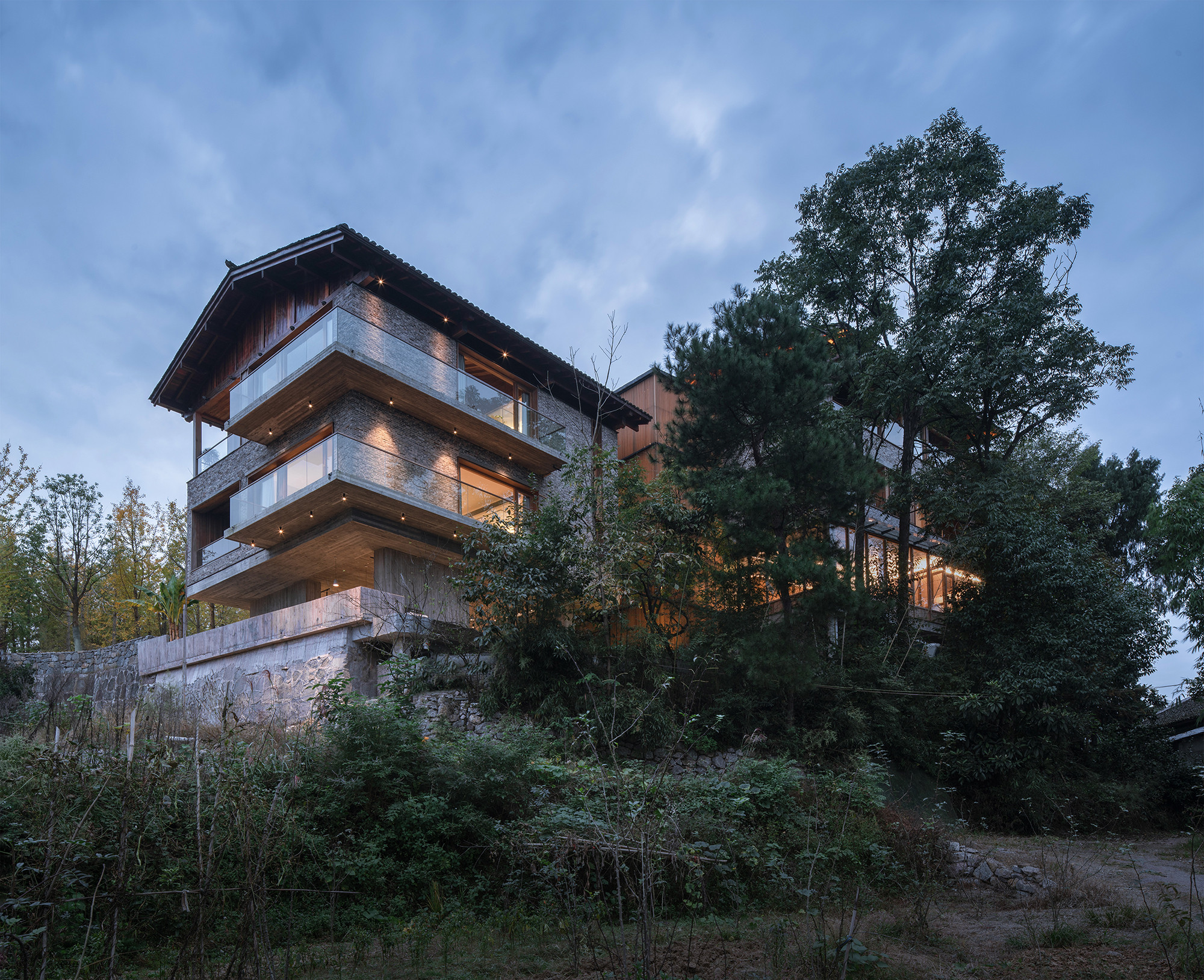

马儿山村有一定的建设条件,作为张家界美丽乡村的典范,已有基本固定的当地游客来源。周末时分,选择来此游玩休憩的游客不少。业主本人在马儿山村长大,自然对这里怀有深厚的感情。民宿的改造既希望可以具备满足回乡居住的舒适条件,又能够不改变原有乡村式的精神寄托之所。
Ma'er Shan village provides decent conditions for construction; meanwhile, as an example of Zhangjiajie's "Construction of Beautiful Villages" campaign, the village also has a stable tourism demand from local tourists, especially during weekends. The estate owner has a deep reminiscence towards the village as the birthplace; therefore, the project was asked to facilitate the owner's need for comfortable stays during home returns and maintain the spiritual importance defined by its rural characteristics.
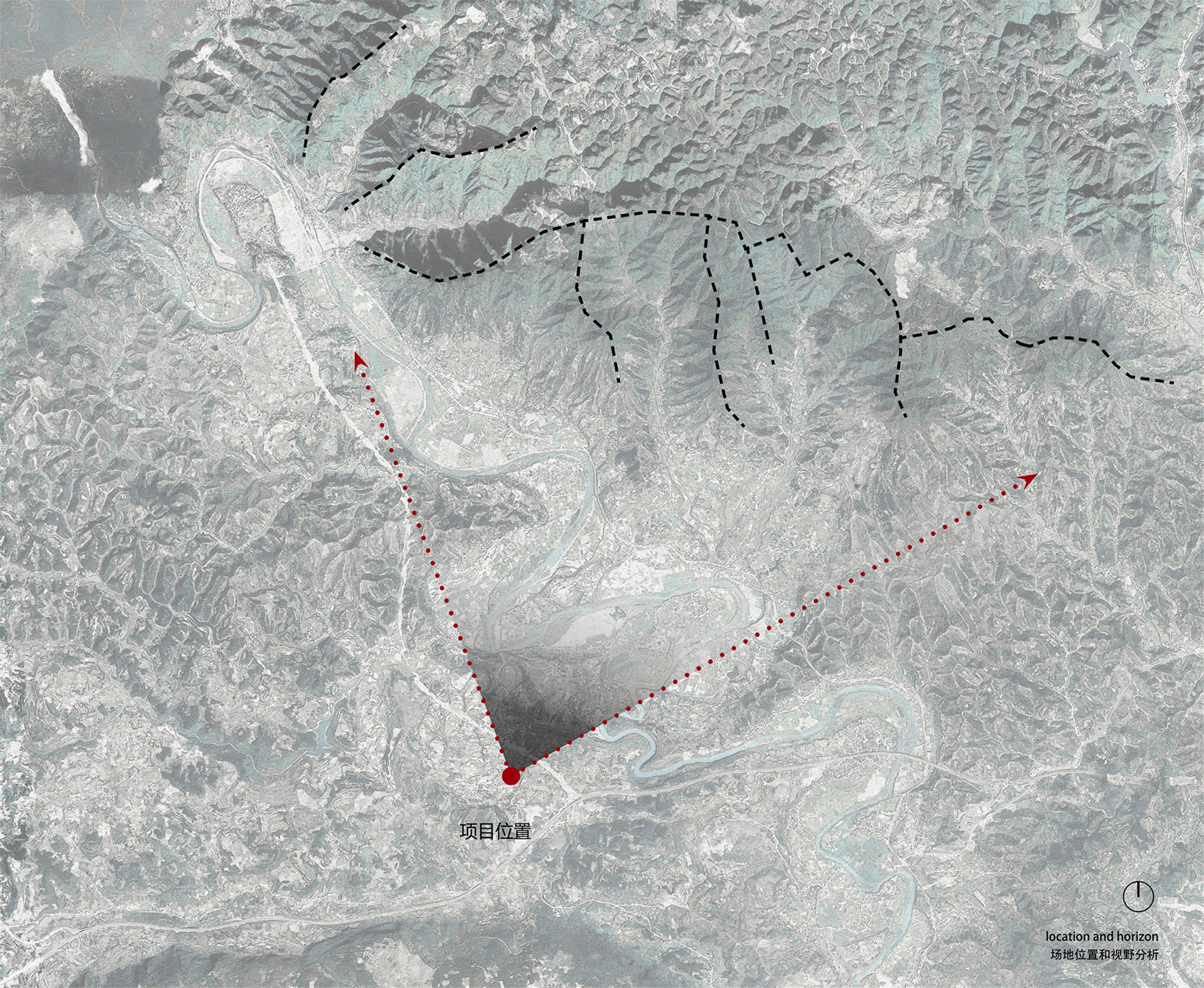

场地策略和场所精神
建筑用地是由三个宅基地组成,呈长条状,在东西方向上有将近3米的高差,两个宅基地位于西侧,一个宅基地位于东侧下端,刚好建筑就形成了两个主体量,一高一低,一大一小,中间用一部半通透的楼梯廊道连接两边。而场地南高北低,我们利用原有场地的关系顺势挖了一部分地下空间,作为后勤储藏和设备用房,东侧的这部分高差则被设计成一个开放的灰空间,为客人提供半室外的灵活使用空间。场地中的水系景观也顺着室外场地台阶逐级流下,形成多个小瀑布水口,构成的流水声可一直伴随着行走体验。
The construction site, consisting of three homestead areas, has a narrow shape and a 3-meter height difference from east to west. Two homestead areas located at west combined, with the lower one located at the east, together established bases of two main structures of the entire residence: the upper-wide section and the lower-narrow section, connected through a half-transparent sky bridge. The field's height difference between north and south was utilized to create an underground section used for maintenance storage and equipment closets; the east side vacant space caused by the height difference between east and west was used to create an opened-up gray space that serves as a multipurpose semi-outdoor area for residents' various needs. The landscape water system in the field follows the path of outdoor steps, forming multiple mini waterfalls, enriching the walking experience with a continuous audio presence of water streams.
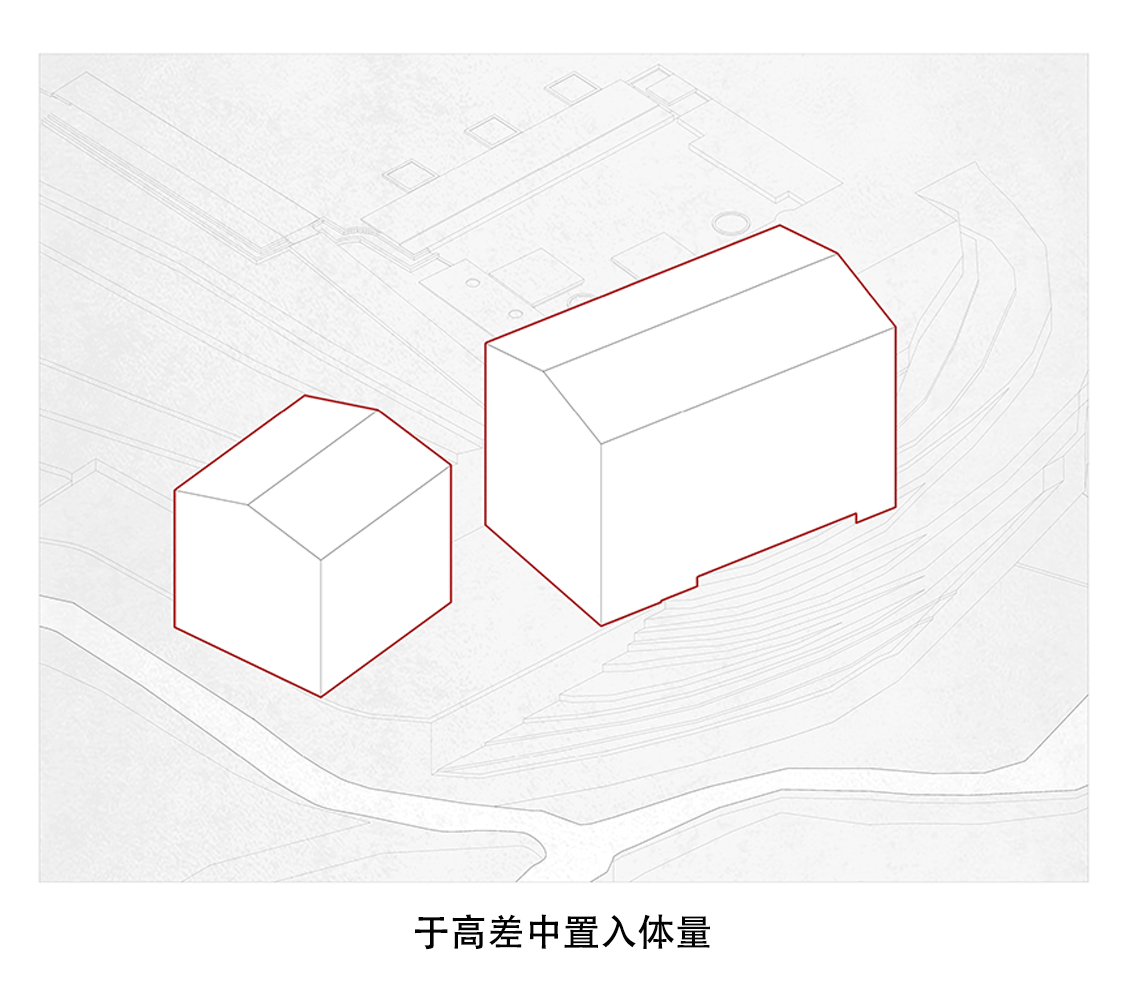
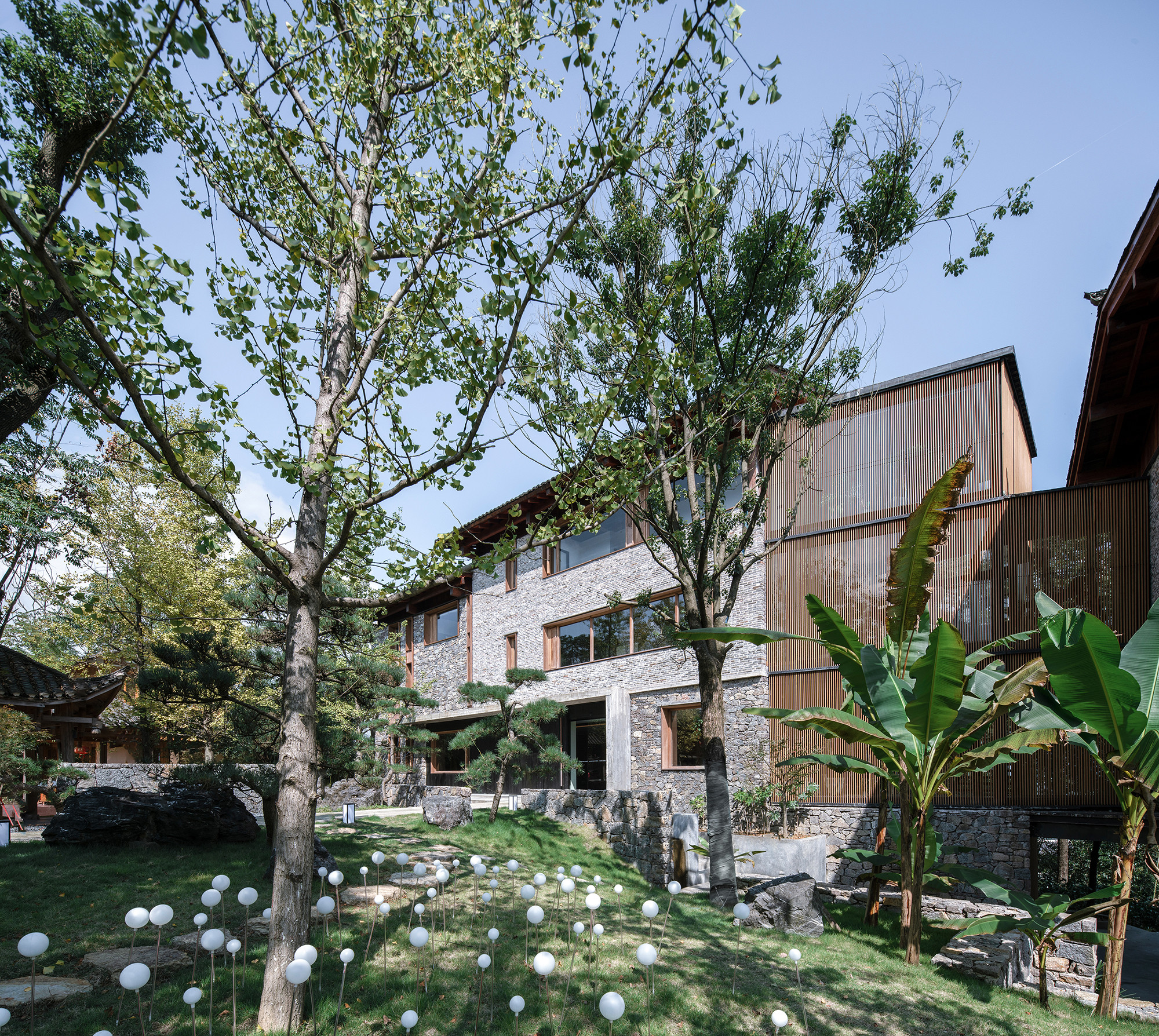
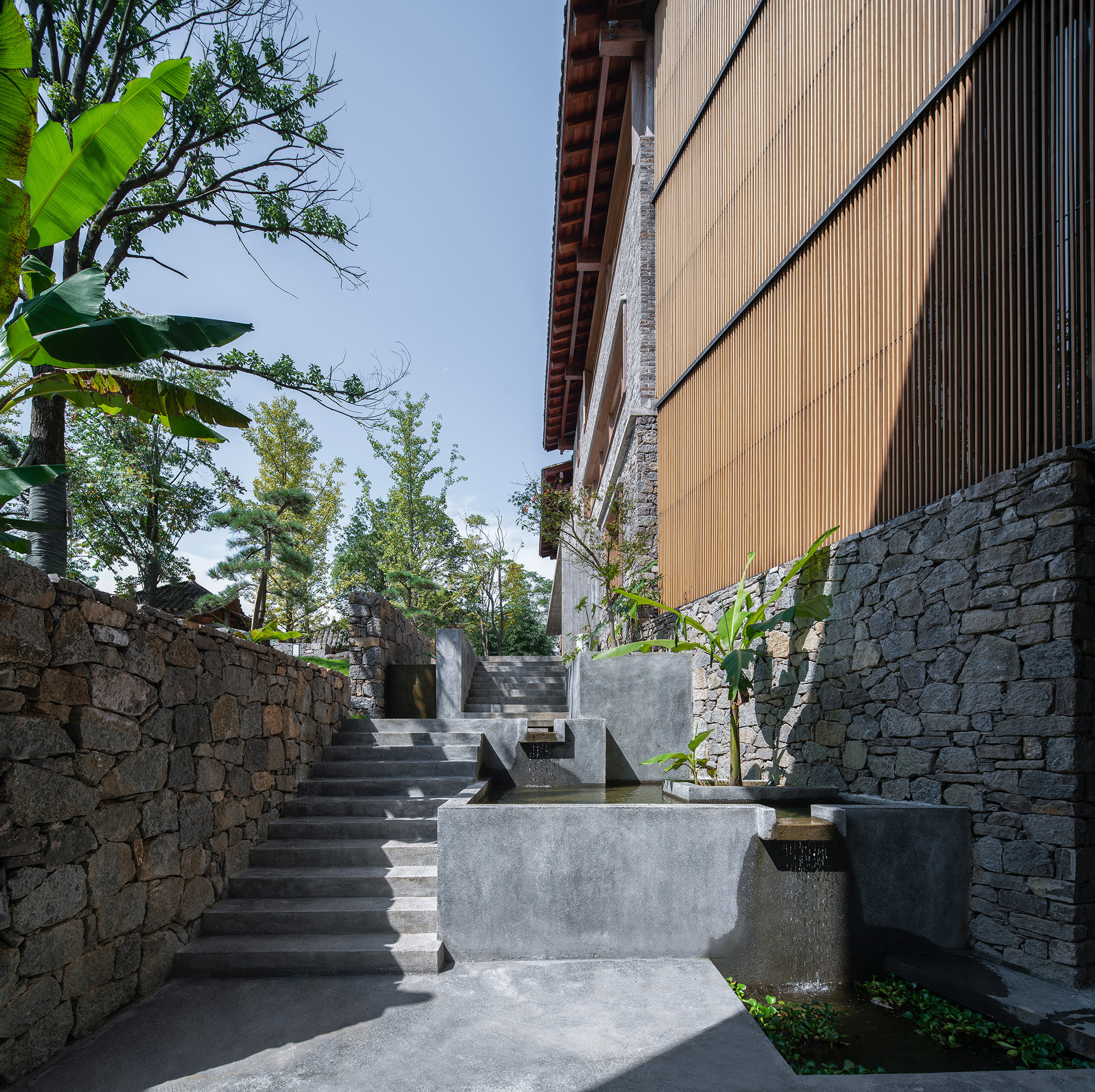
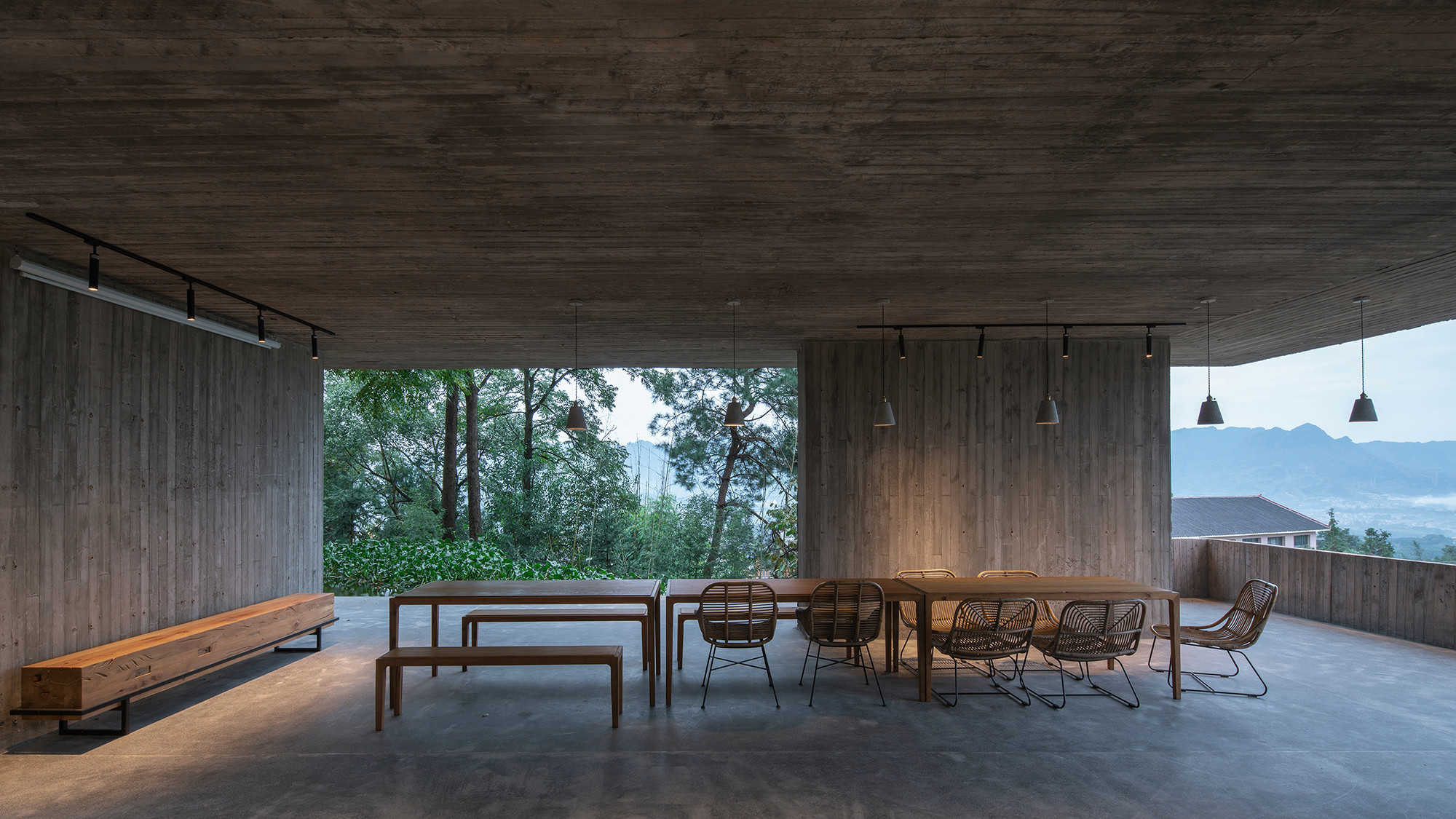
场地绝不只是场地本身,周围的树木、相邻的房舍、远处的山屏、一侧的田野、围合的竹林都是场地的一部分。人融入在其中,建筑的空间和视野也围绕其展开。
The residence boundary is far beyond the perimeter of the building itself; the surrounding woods, neighboring country houses, distant mountains, nearby farmland, and bamboo copses all serve as a vital part that together assembled the residence's vibrant environment. With visitors immersed within, such an environment also centered at all residence's spacing and scenic designs.
远山近林是场地内最直观的感受,为了不改变原有的场所感,树木被尽可能地保留。建筑被植被包裹,人又被建筑包裹,在保留原始“犹抱琵琶半遮面”的隐秘感同时,行走在地面层时的体验也变得层次丰富了起来。同时,不同季节林木的形态不同,环境的通透性也会变得不同,在夏季茂密的叶片与冬季裸露的枝干掩映下,建筑的可视度也有所差异。
Distant mountains and neighboring woods compose the most distinctive viewing experience gained at the center of the field; therefore, surrounding woods were preserved mainly to continue the field's sense of space. The residence is sheltered by woods, while the residence shelters the people within; such a charming paralleled relationship not only retained the mysteriousness of this half-hidden space but also elevated the ground-level walking experiences. Changes in plantations' posture during four seasons can also impose influences in surrounding opacity, as the residence will get a different look during the lush greens of summer than the baldness of winter.


远山作为关键要素,在空间中希望有着不同方式的观看体验:在建筑的下部分空间,山体是隐隐约约地在树干间透出来,往上行走,视野开阔的同时,连续的山屏也逐渐展现。同时通过客房的不同开窗方式,远山被引入的状态也不同,有长条卷轴式,有框景片段式,有连续断框画幅式,对不同的空间尺度和类型进行呼应。
As a significant scenic element, the view of distant mountains was thoughtfully placed throughout various spaces, hoping to be seen through different manners. While the shape of distant mountains remains half-hidden by surrounding woods in the lower section of the residence, as people going upwards, with their field of view expanding, the expansive landscape of continuous mountains will also gradually unfolds itself. The way distant mountains have been introduced into interior designs of guest rooms also varies through different windowing designs, including long scroll landscape, framed scene, and continuous segmented frames, each of them, contemplates with different types and sizes of interior spaces.
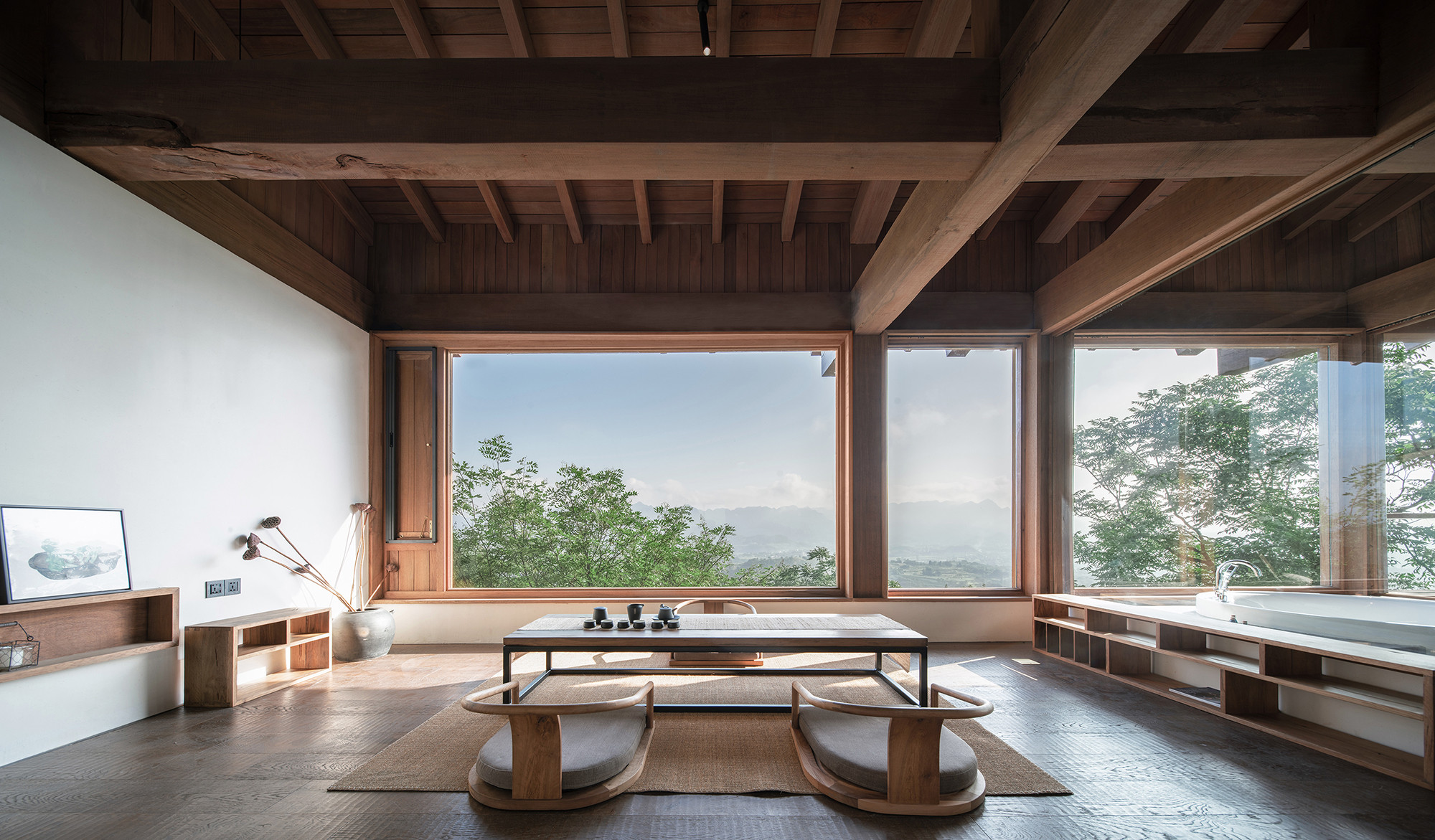
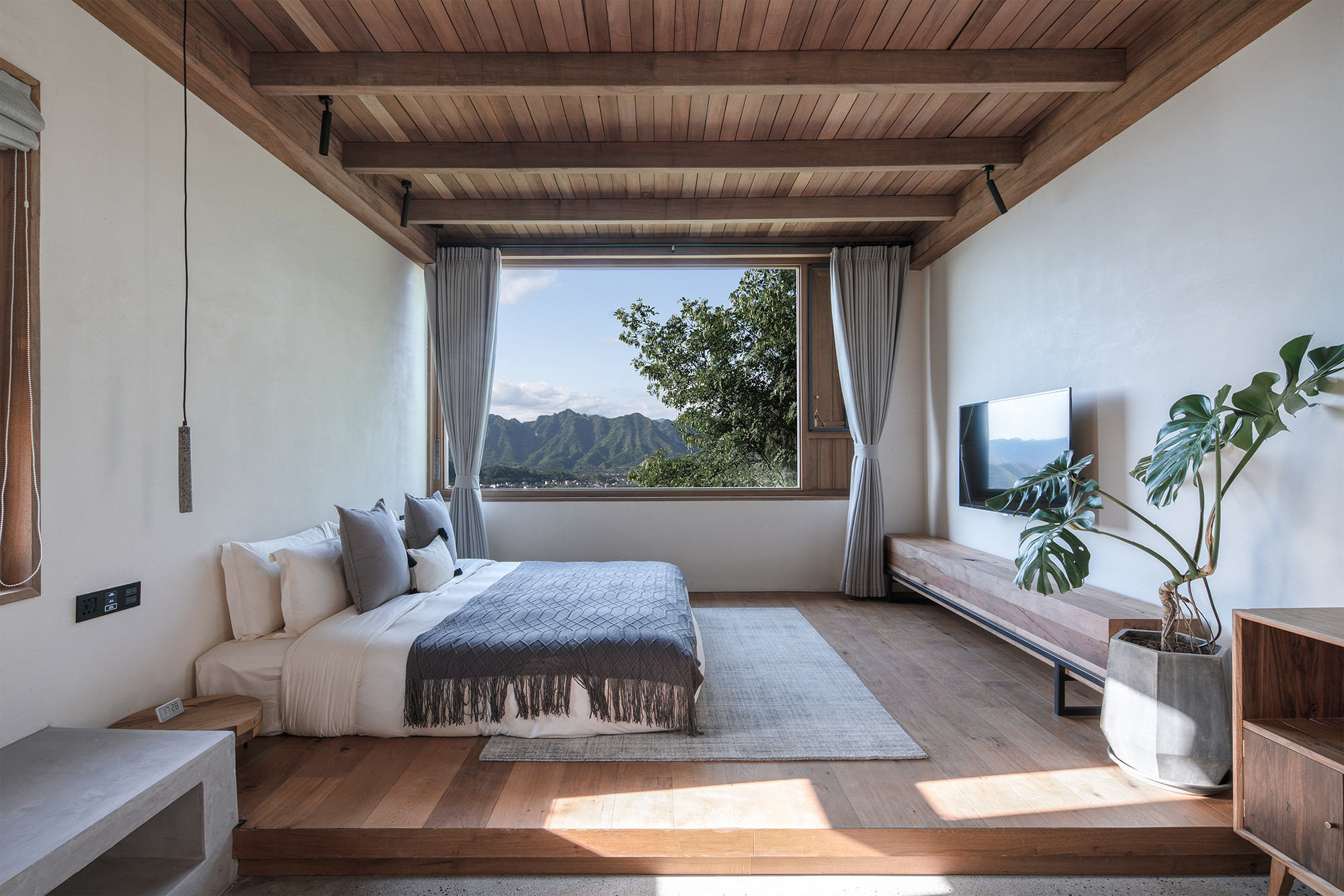
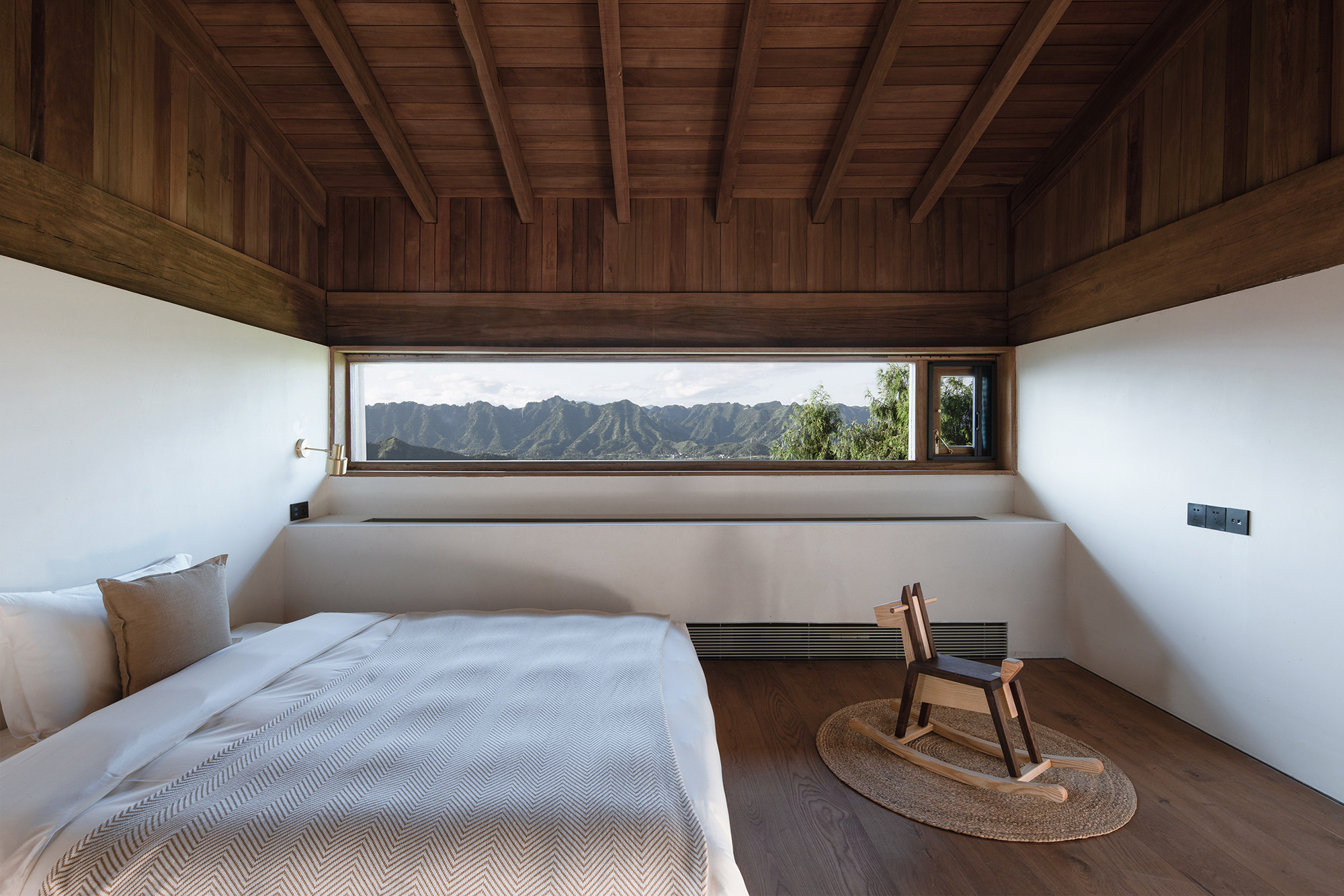
远山近林,情感共鸣
一层接待大厅是一个横向展开相对低矮的空间,压缩了视觉和体感。右行下几步台阶进入下沉的休闲区域,连续的横向玻璃窗提供了相对开阔的视野。低层树木枝叶繁盛,层叶荡漾,偶见远山。从休闲厅逐级绕行至左侧,我们设置了水吧和早餐厅,吧台以天然的自然景观作为背景,斑驳的竹影形成天然的动态画面。
The reception lobby on the first floor is an expansive yet vertically contracted space, compressing its visual volume and physical perception. Few steps downwards to the right, a sunken lounge area is located, equipped with continuous horizontal windows allowing a relatively expensive view. Lower level vegetation's lush leaves and branches create a half opaque screen with shapes of mountains looming in the distance. The breakfast room with a wet bar, which has an ever-changing natural background formed by mottled shadows of bamboos, is located further into the left.
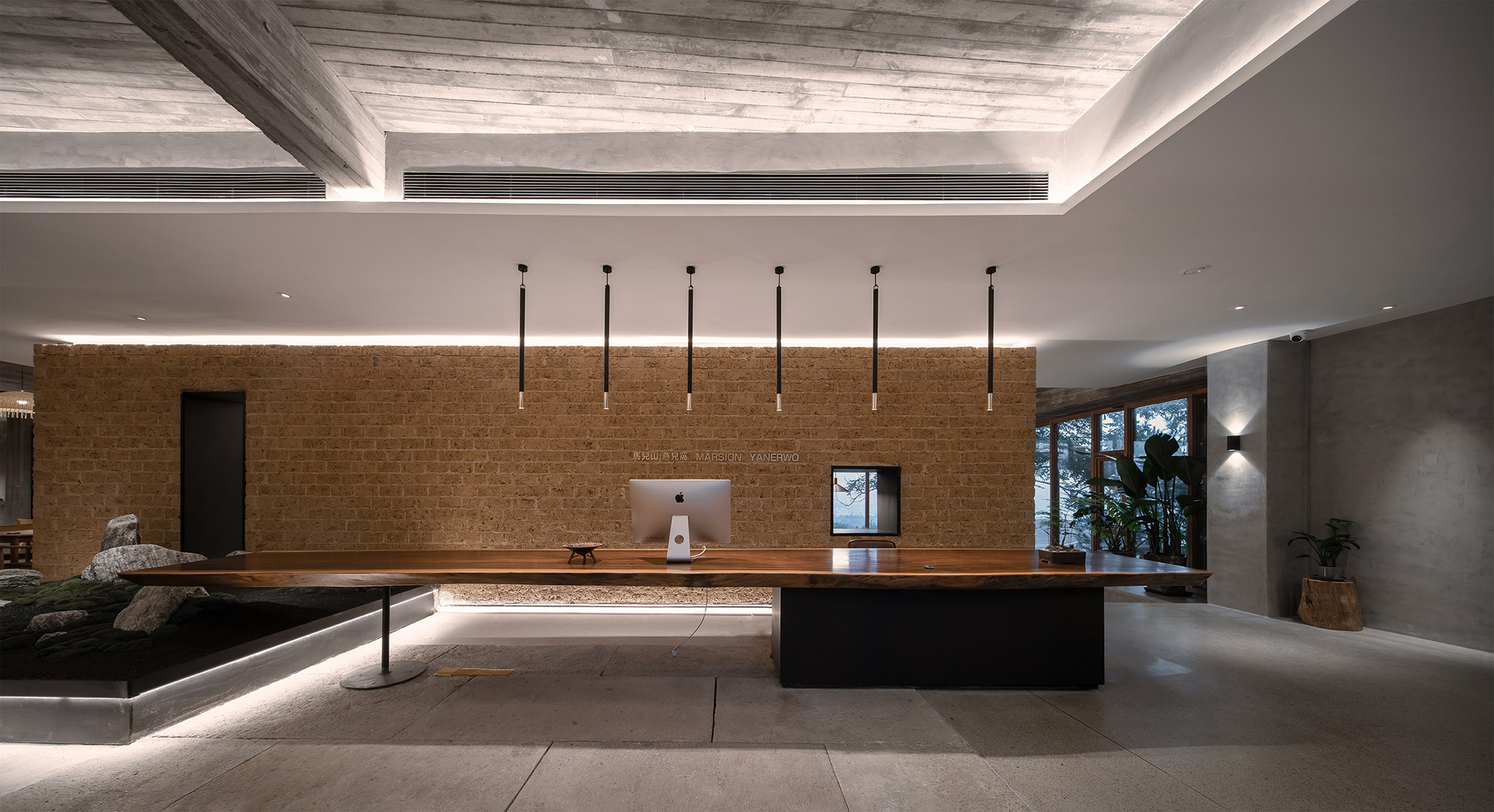
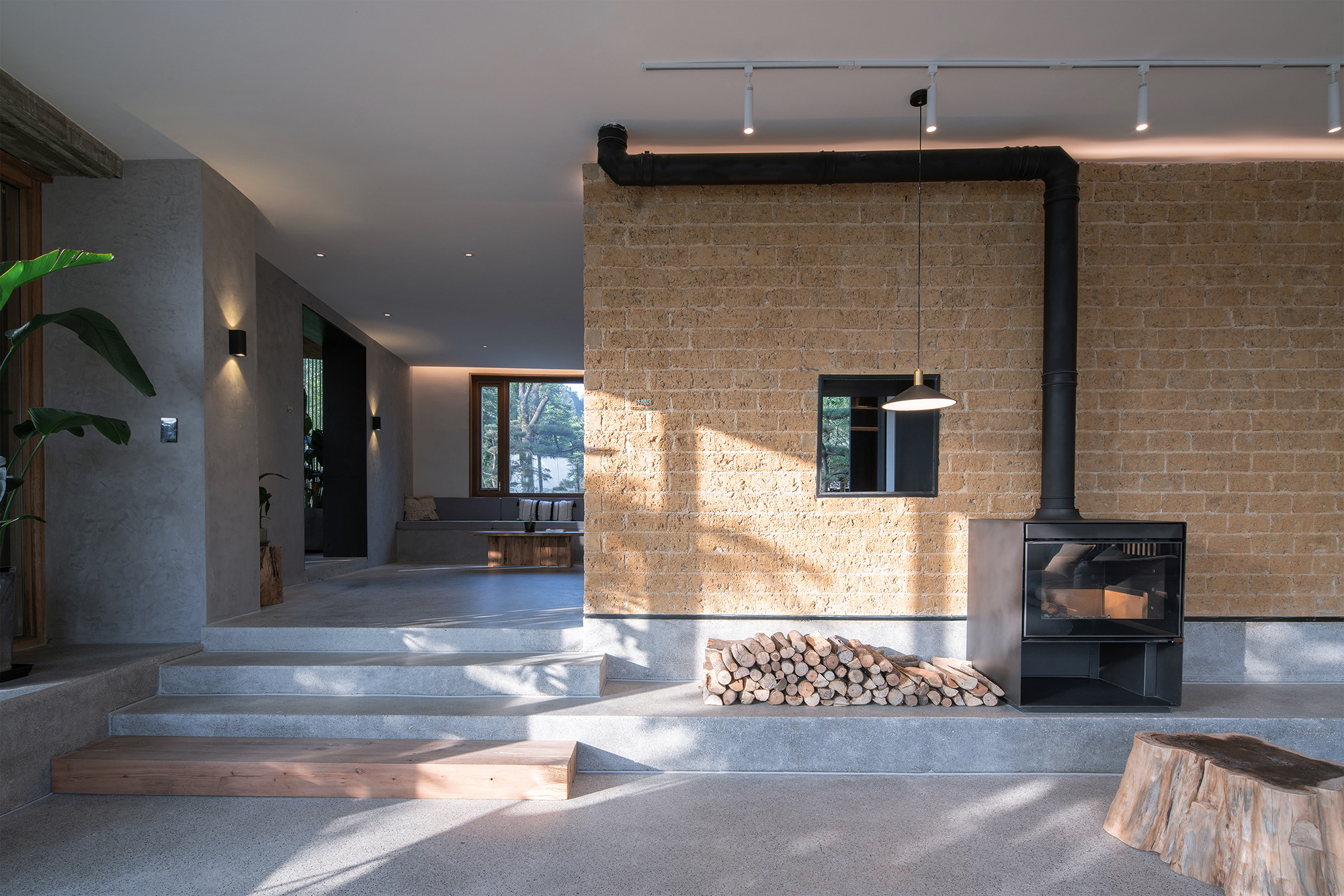

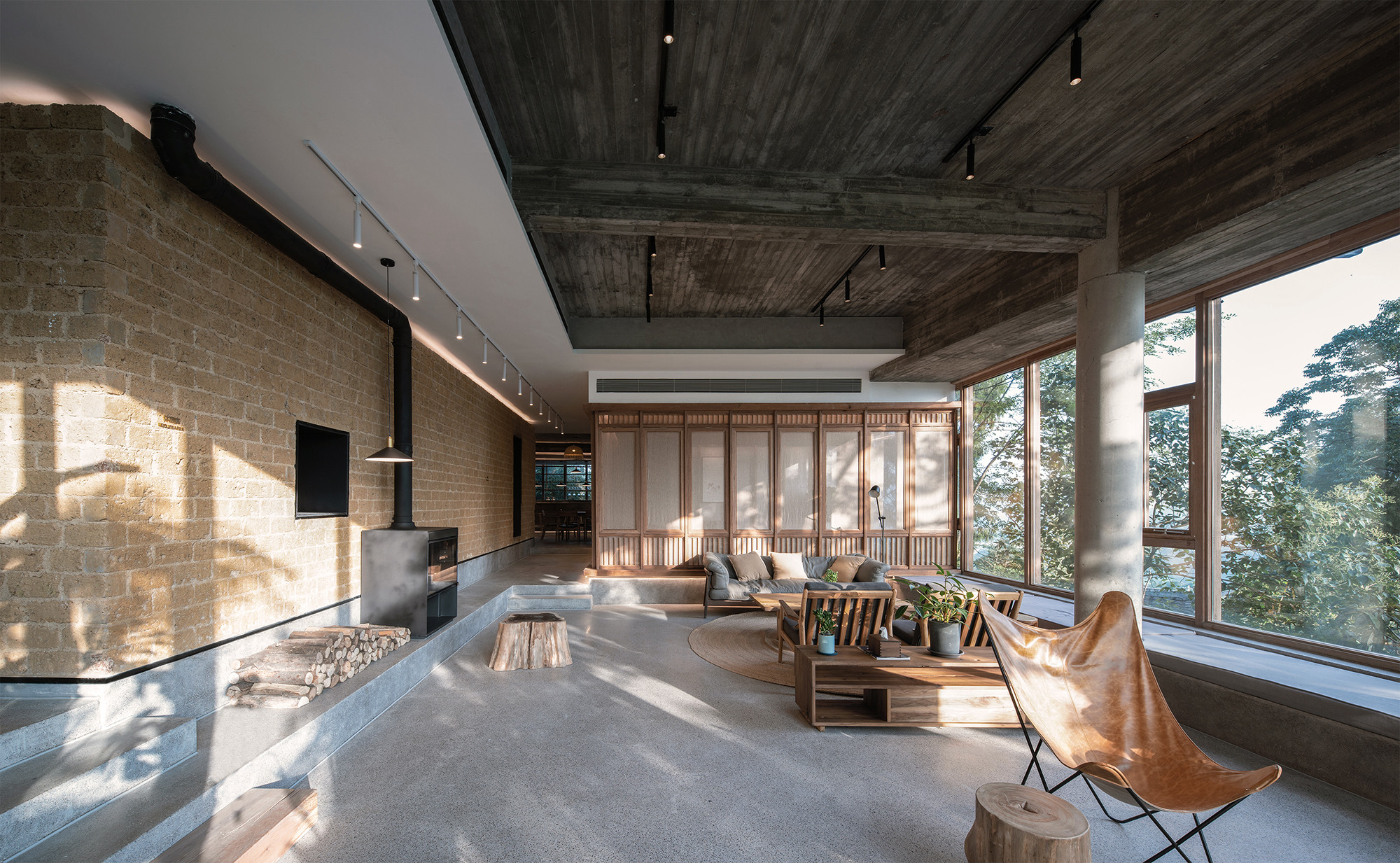
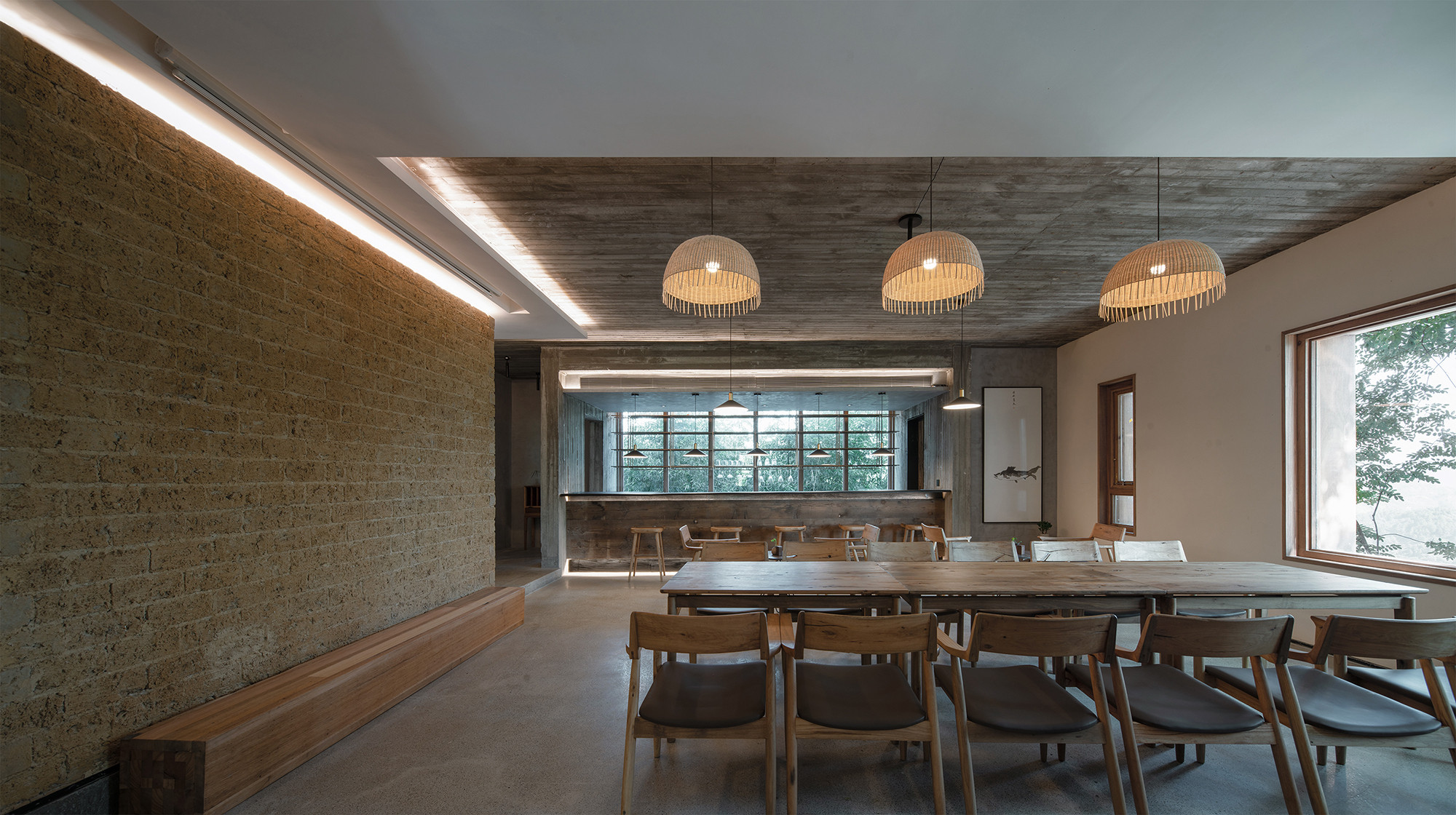
从接待厅穿过竹格栅连廊便是一层的两个客房,东北侧客房视野开阔,村子的田野景观和远山都能引入客房,不同季节入住会看到田地里不同颜色和种类的作物。客房布置简洁,空间围绕两个方向的景观展开布置,床朝向北侧的远山,喝茶区则朝向东侧田野,户外有一个L形的休闲阳台,卫生间干湿分离,开放自由,浴缸设置在大玻璃窗边,在泡澡时能让身体更接近自然。
Through the reception hall and bamboo fenced corridor, two guest rooms were placed. The guest room at the northeast side has a capacious sight, covering views from close by farm fields to mountains in the distance. Colors and crops of farmland change throughout seasons, giving an ever-changing stay experience across the year. The interior has a simple design, with the space layout focused on views from two directions: the bed is directed towards distant mountains at north; he tea nook, on the other hand, is directed towards farmlands at east. An L-shaped balcony is placed outdoor. The spacious semi-opened-up lavatory equips separate dry and wet areas; the bathtub is placed beside the glass windows to create a bathing experience more closed up to nature.
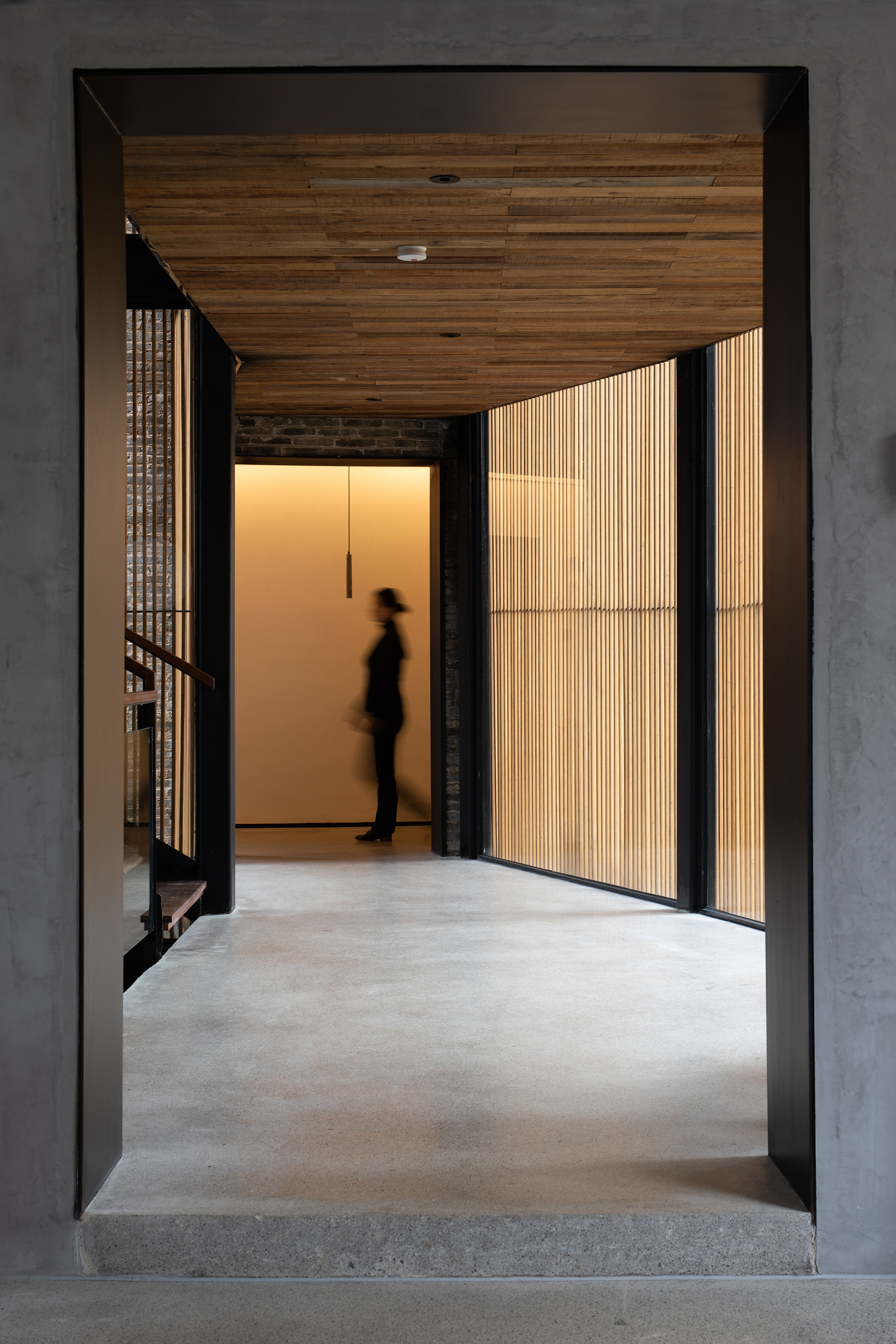
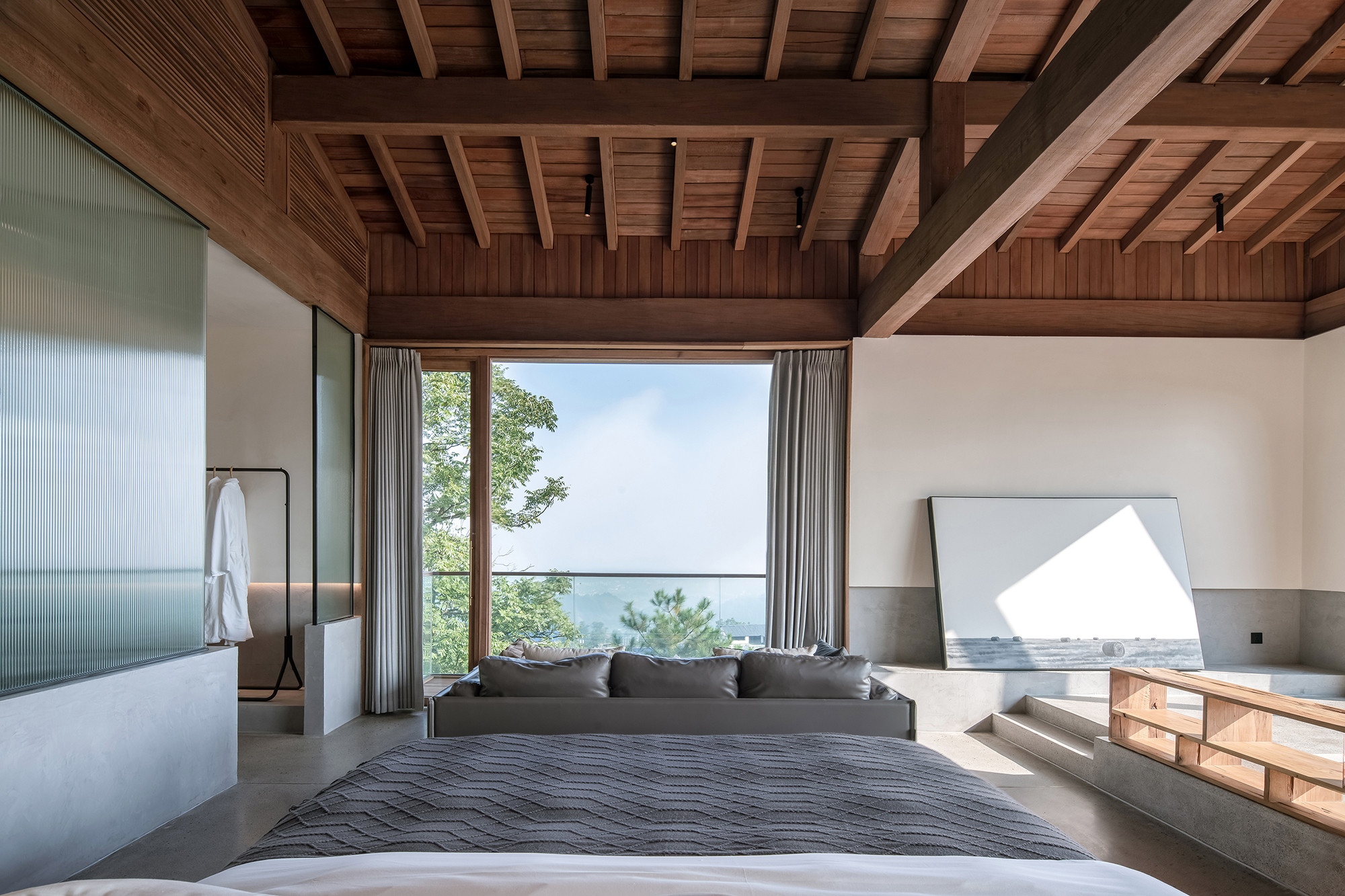

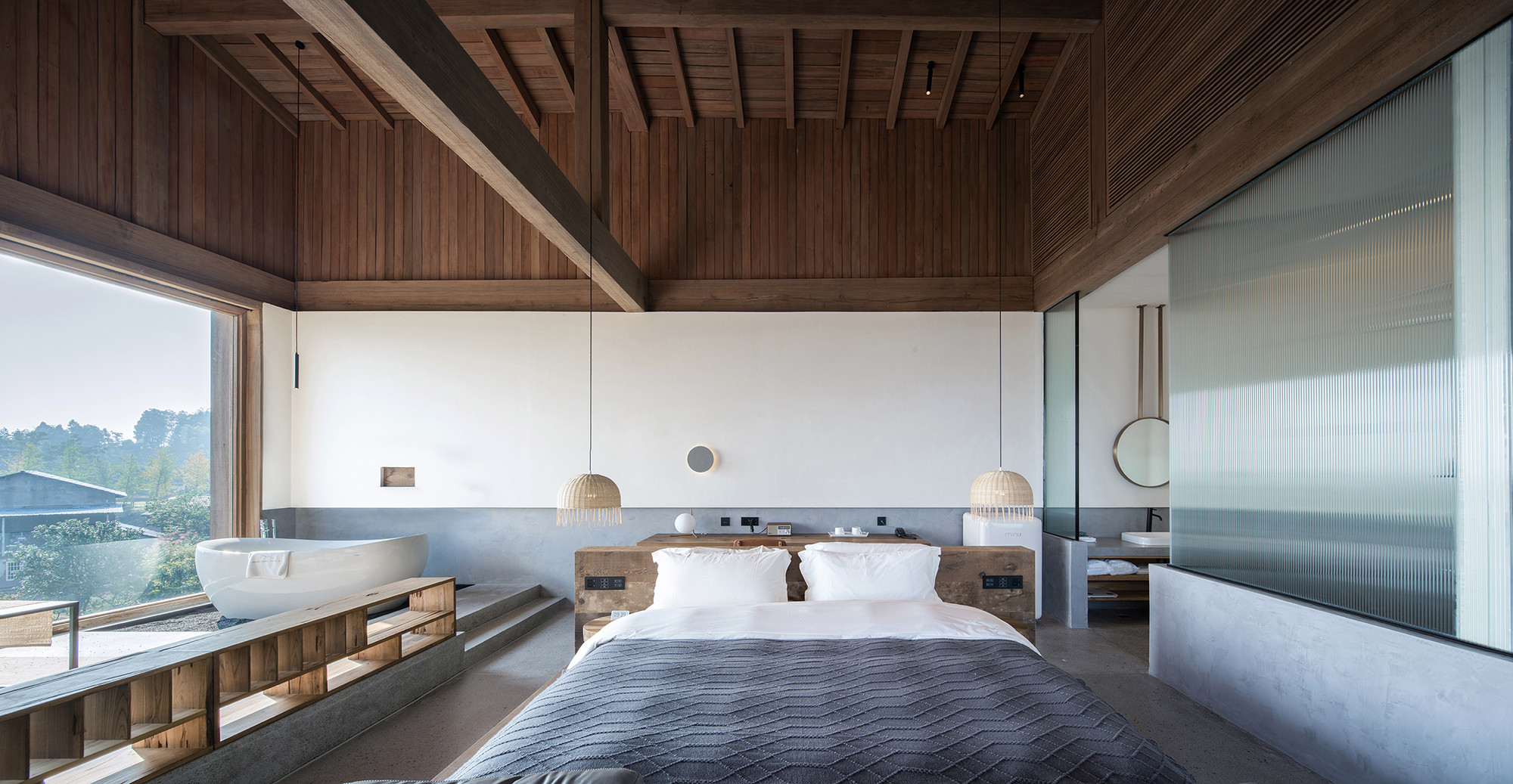
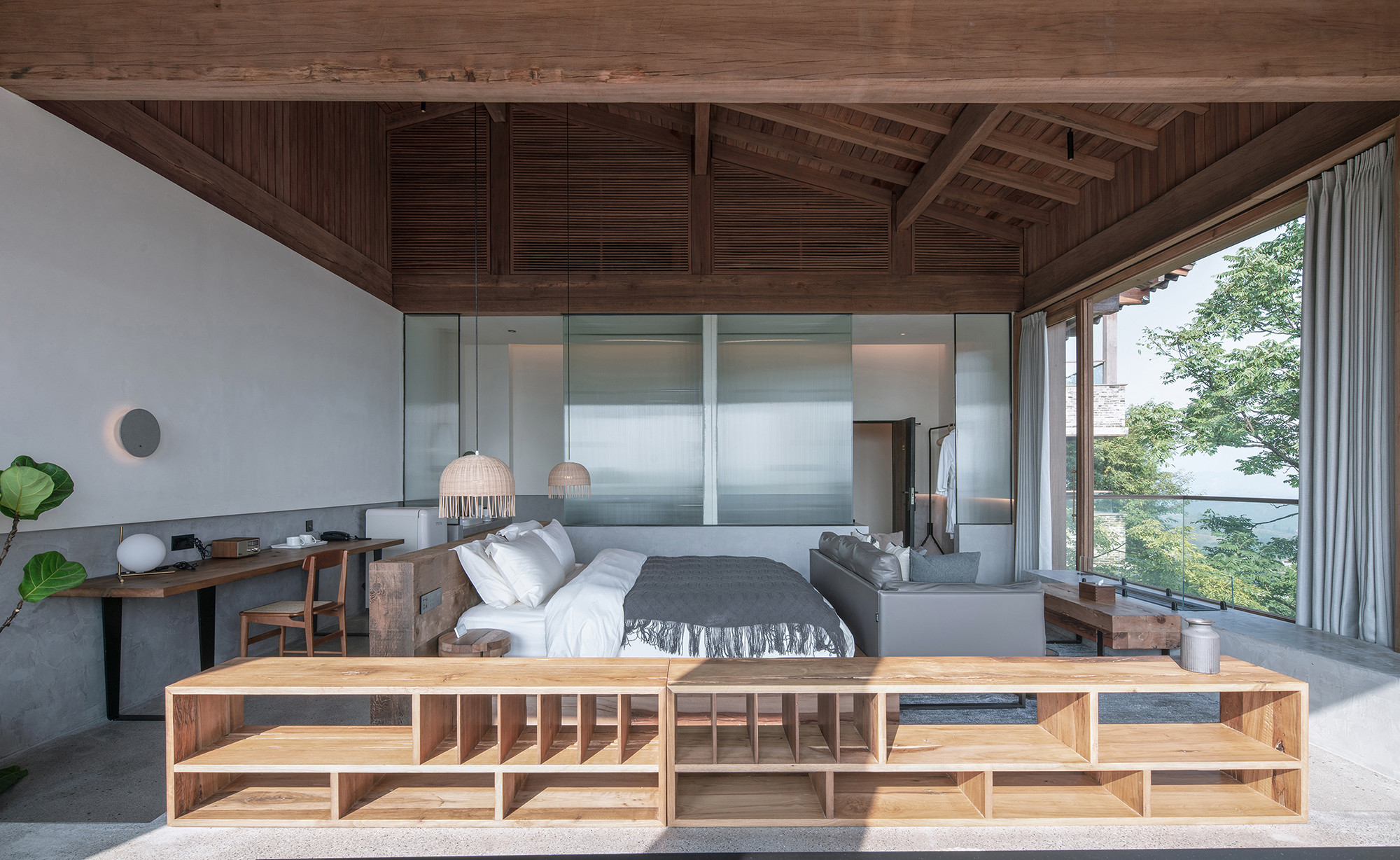
顺楼梯踏步而上,便到了二层的客房,亲子房体验令人惊喜:空间分上下两层,内部有楼梯上下,室内根据不同使用属性设置了不同的高差和地面材料。一层布置一个大床,二层南北两侧分别有两个大床,可以提供一家人的居住体验,亲子客房的二层直接裸露着屋顶的木结构,阁楼北侧开了一条窄长窗,把远处的山景框入窗内,形成横轴画卷。
The second-floor guest room gives a pleasant surprise through great family suite experiences. The vertical space is divided into two levels, with an in-room staircase connecting each other. The interior floor is covered with a variety of materials with high differences due to different area usages. With one double bed placed on the lower floor and two beds each placed on the north and the south side of the upper floor, the family suite could sufficiently accommodate the stay of a whole family. Building's wooden roof structure is exposed to the suite's loft; a narrow landscape window opened on the north side of the loft introduces a scroll view of distant mountains.
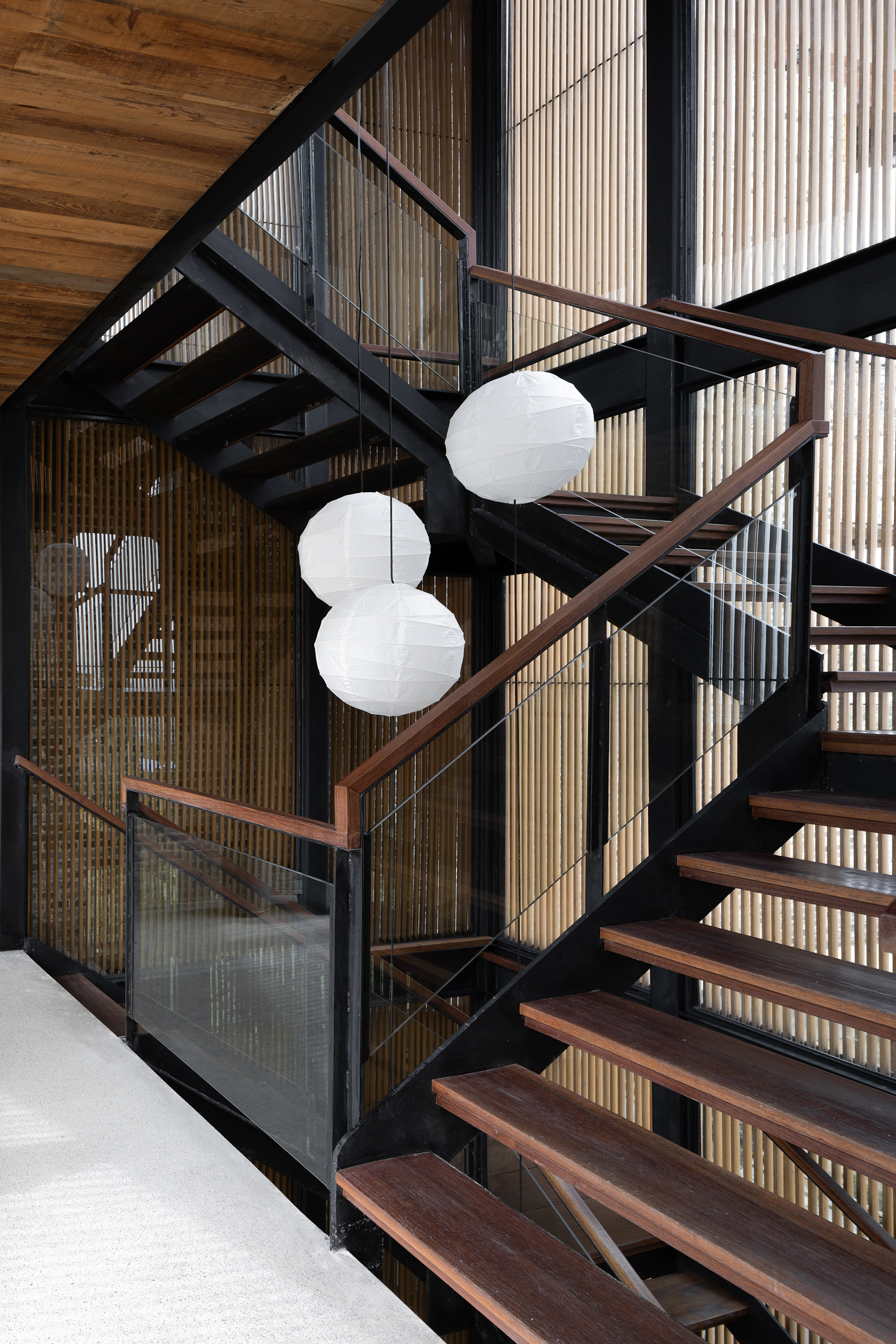
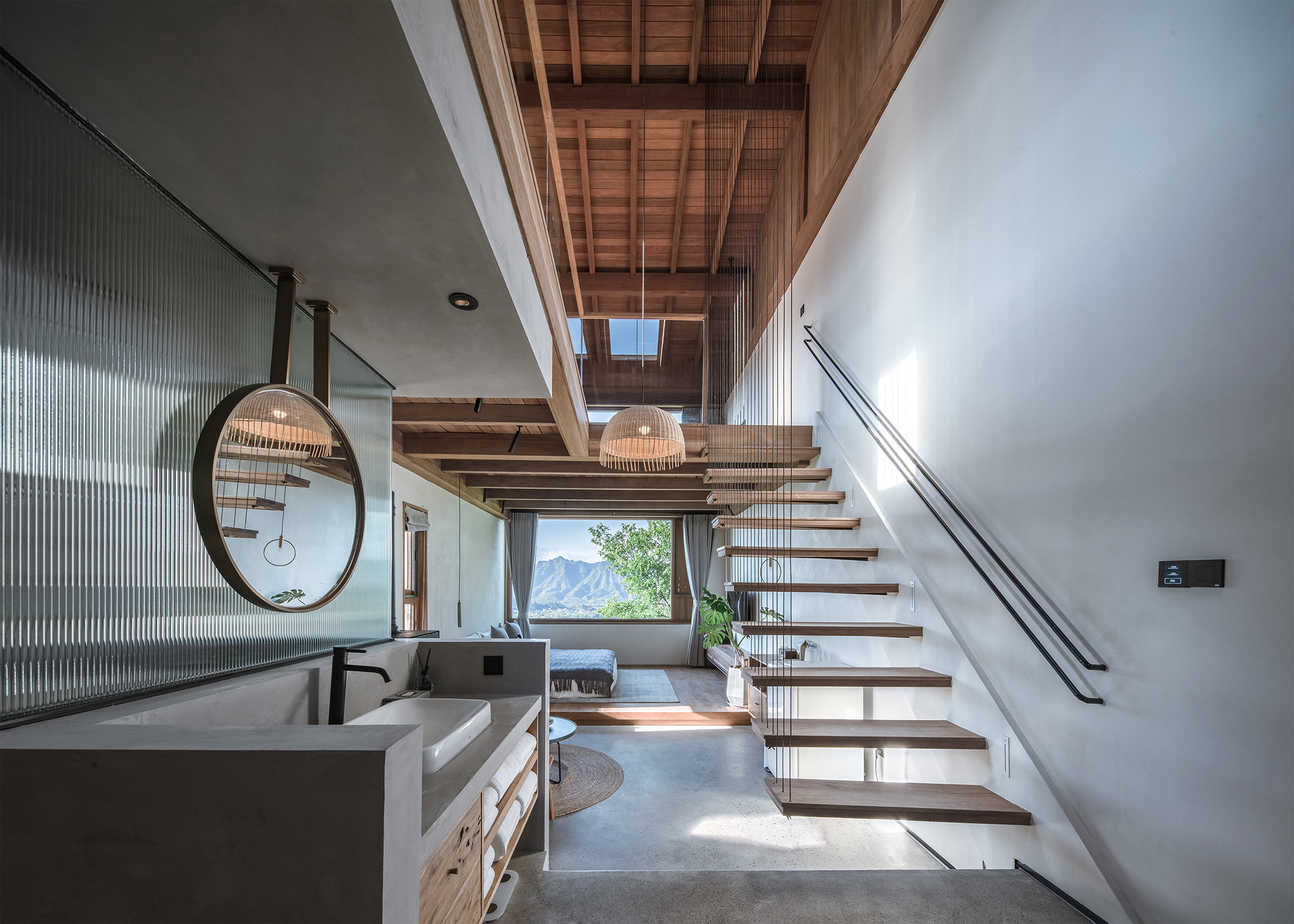
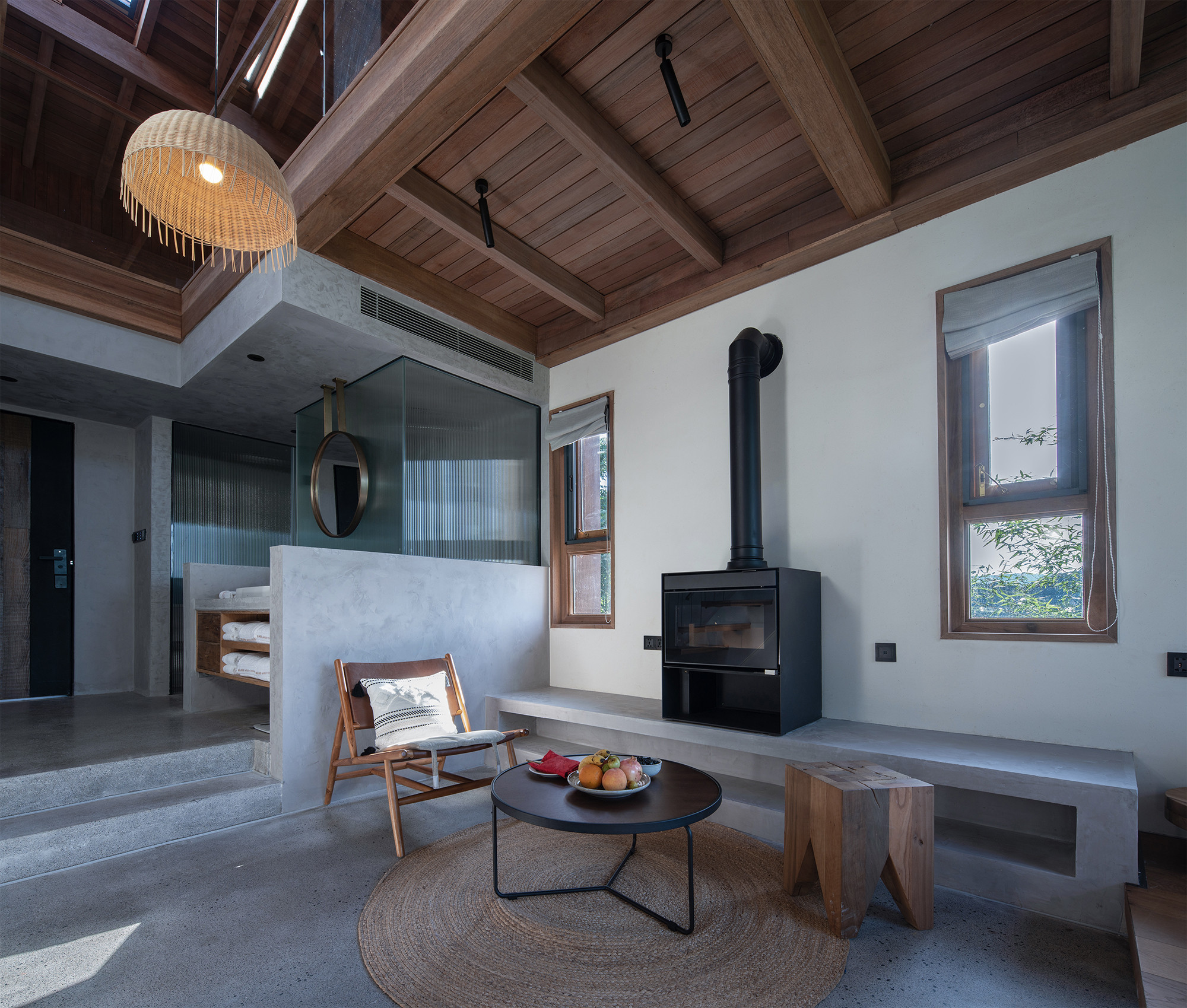
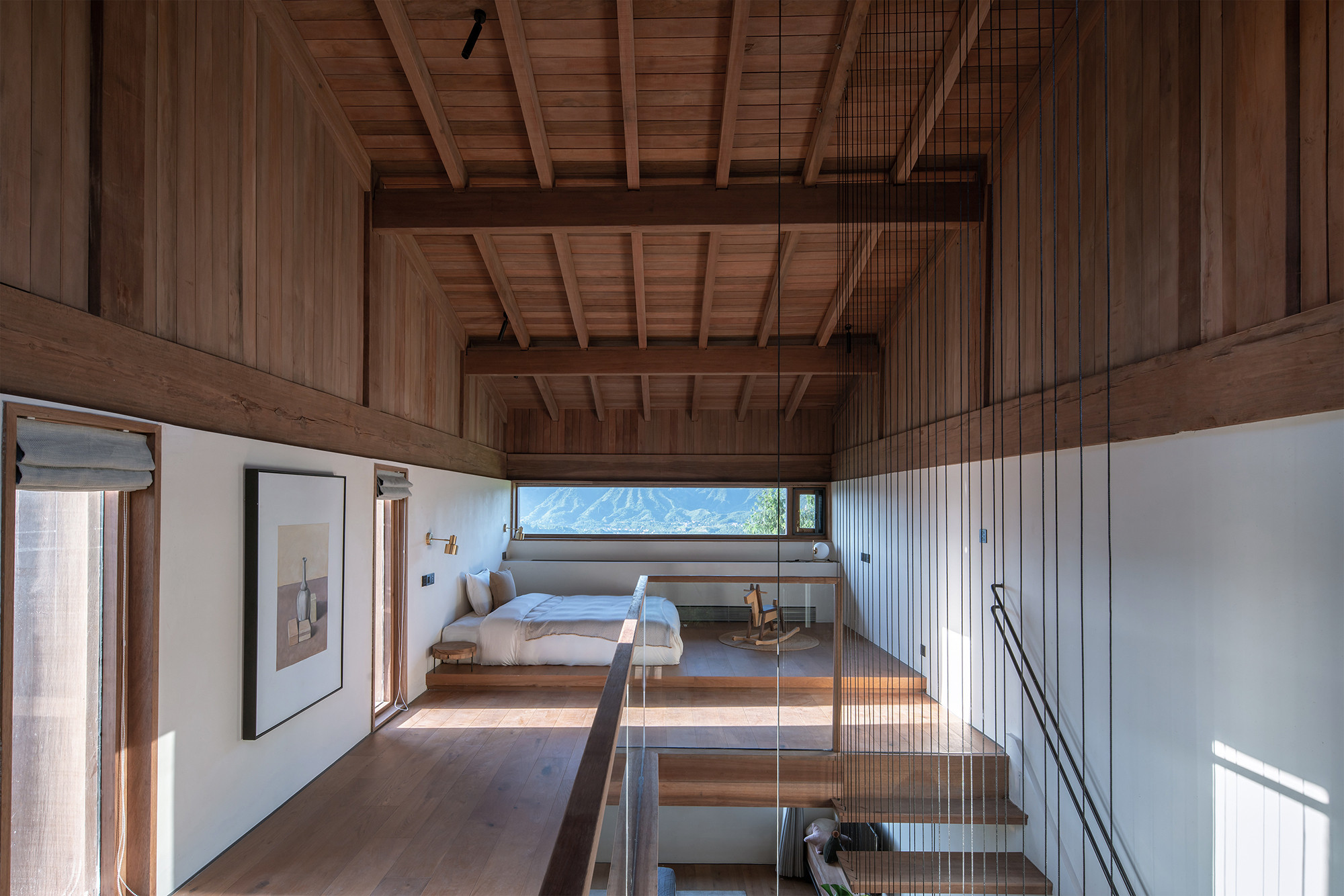
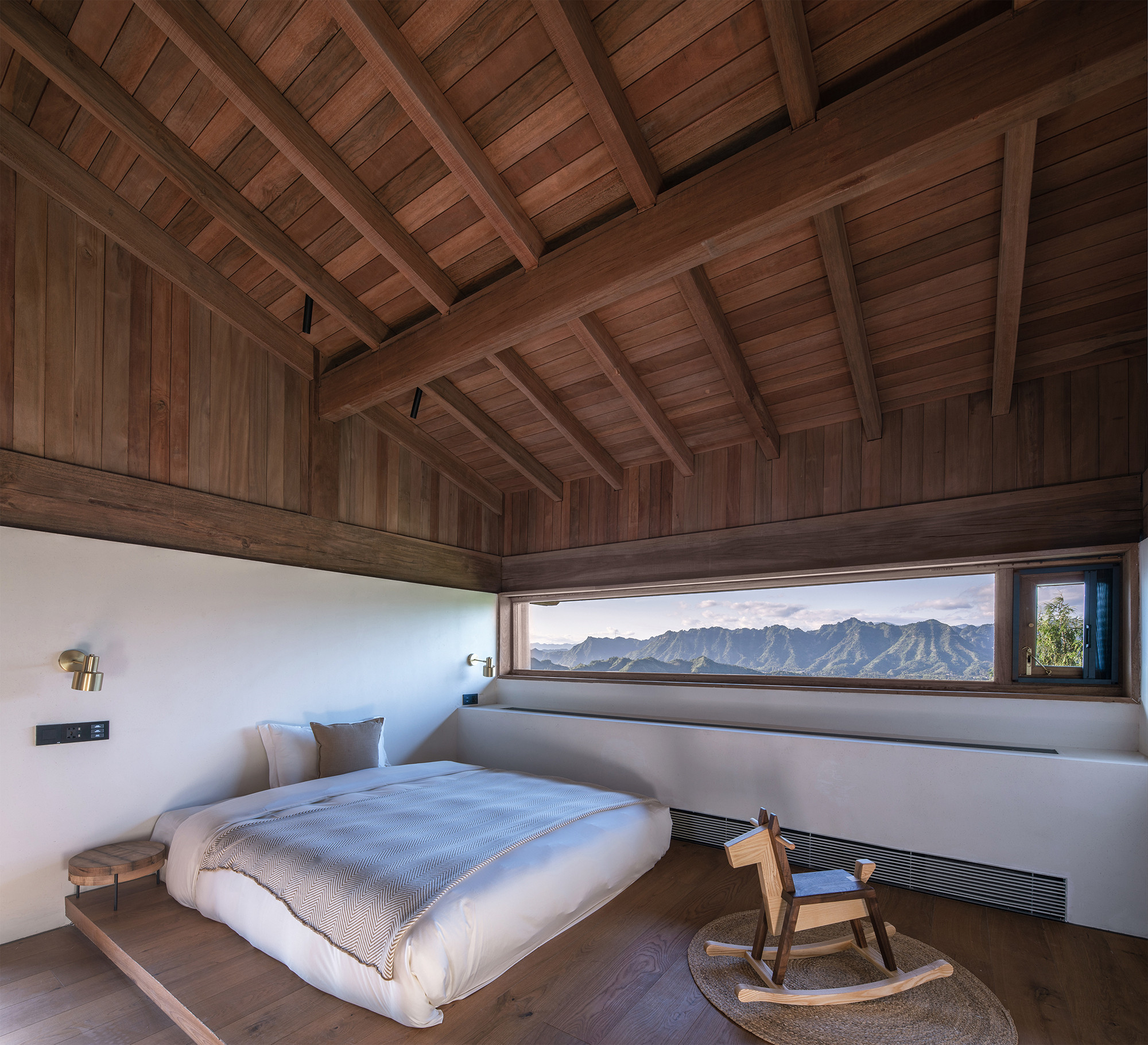
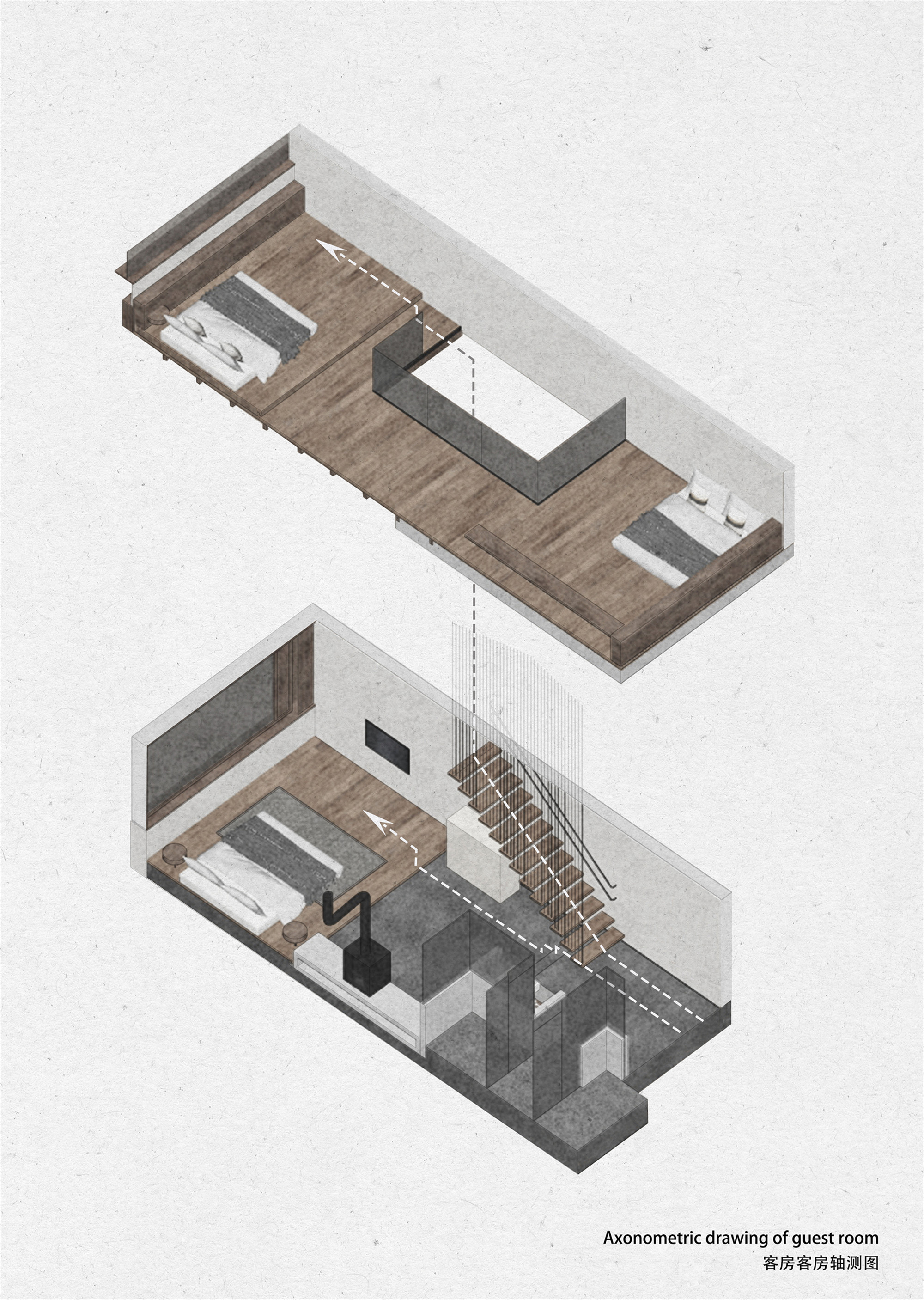
顶层是一个大套房,空间横向延展,从玄关转入便能看到连续的山景被引入室内,视野被完全打开,近处有部分树杈冒出,形成近景远景的不同层次,坐在阳台,微风拂面,喝茶看山,非常舒适。套房在布局上以内天井和浴缸泡池为界分成两个区域,一半是睡觉喝茶区,一半是休闲水吧区,空间通透自由。屋顶木构梁架裸露而出,结构与空间的关系一目了然,清晨鸟叫声响起,打开窗帘便让人心旷神怡。
The top floor is a grand suite with expansive horizontal space. After entering through the porch, the residents will be embraced with a distant continuous mountain view, forming a layered view together with several popped-up tree branches close by. Resting on the balcony with a gentle breeze and a pot of tea, visitors will enjoy a tranquil experience with the view of mountains. The suite's layout is divided into two sections by the bathtub and the interior patio. The first section accommodates sleeping and tea drinking, while the second section serves as a leisure space with a wet bar. The uninterrupted flow of space and exposed wood roof structure makes the relationship between the structure and space conspicuous to the observer. Early in the morning, with birds twittering, visitors can experience the refreshment simply by opening up the curtain.


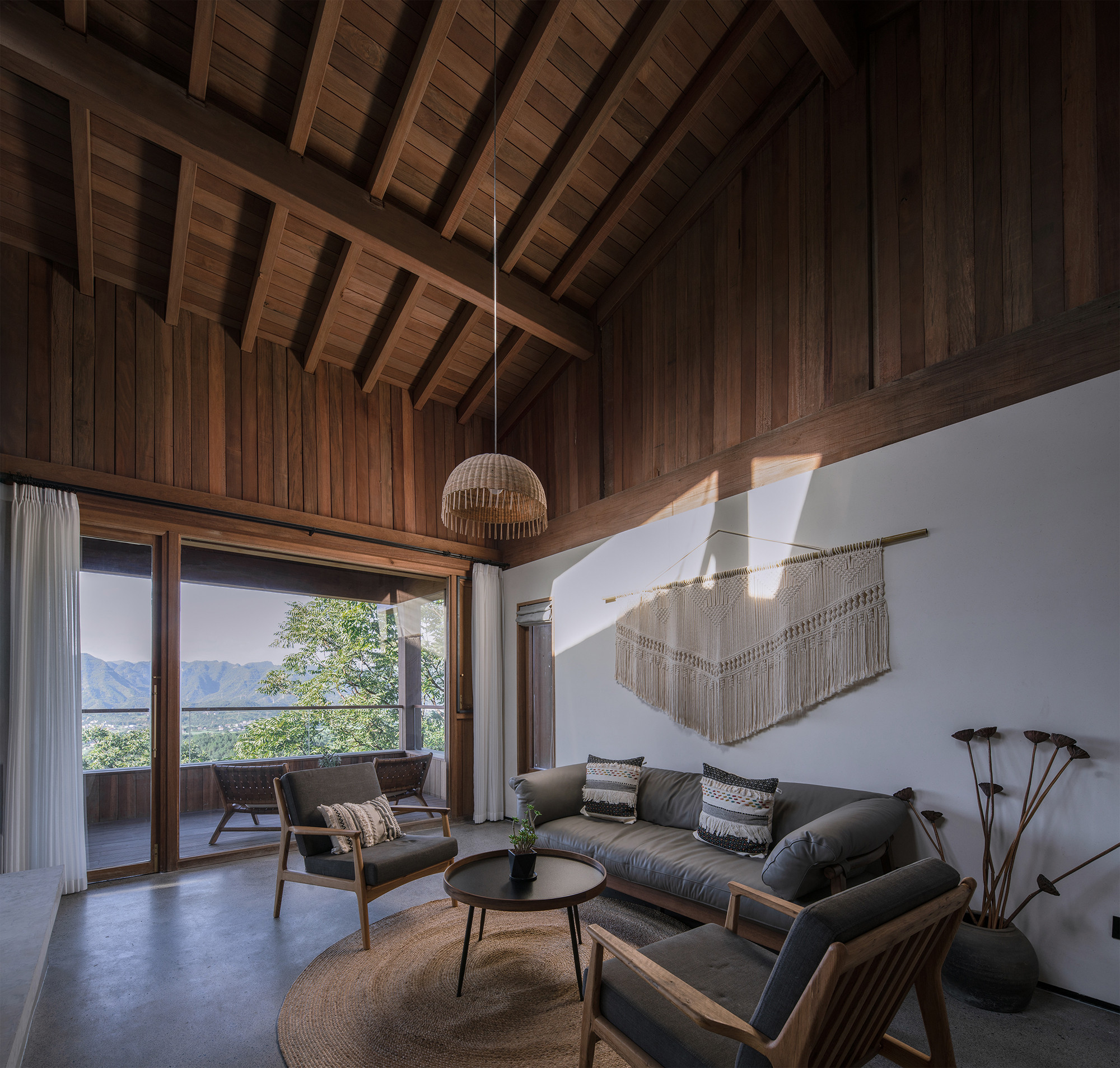

结构体系和在地化材料建造
在建筑的立面材料的选择上,我们更希望能具有在地性,回到自然与建造的关系上,充分利用当地材料,既控制建造成本,又能便于找到当地工匠施工。如垒毛石、土砖墙、水洗石、水磨石、青砖墙、青瓦等,都是当地非常常见的用材。这些材料施工工艺简单,易取材,建造精确性易把握。
We hope the material selection of the residence's facade to inherit a sense of locality, to support the relationship between construction and nature, and to utilize locally sourced materials and local craftsman that lowers not only construction expanses but also reduces logistical costs. Materials like rubbles, mud bricks, washed granolithic, terrazzo, gray bricks, and little blue tiles are all commonly used by locals; they are easy to source, craft, and make the construction accuracy easily manageable.
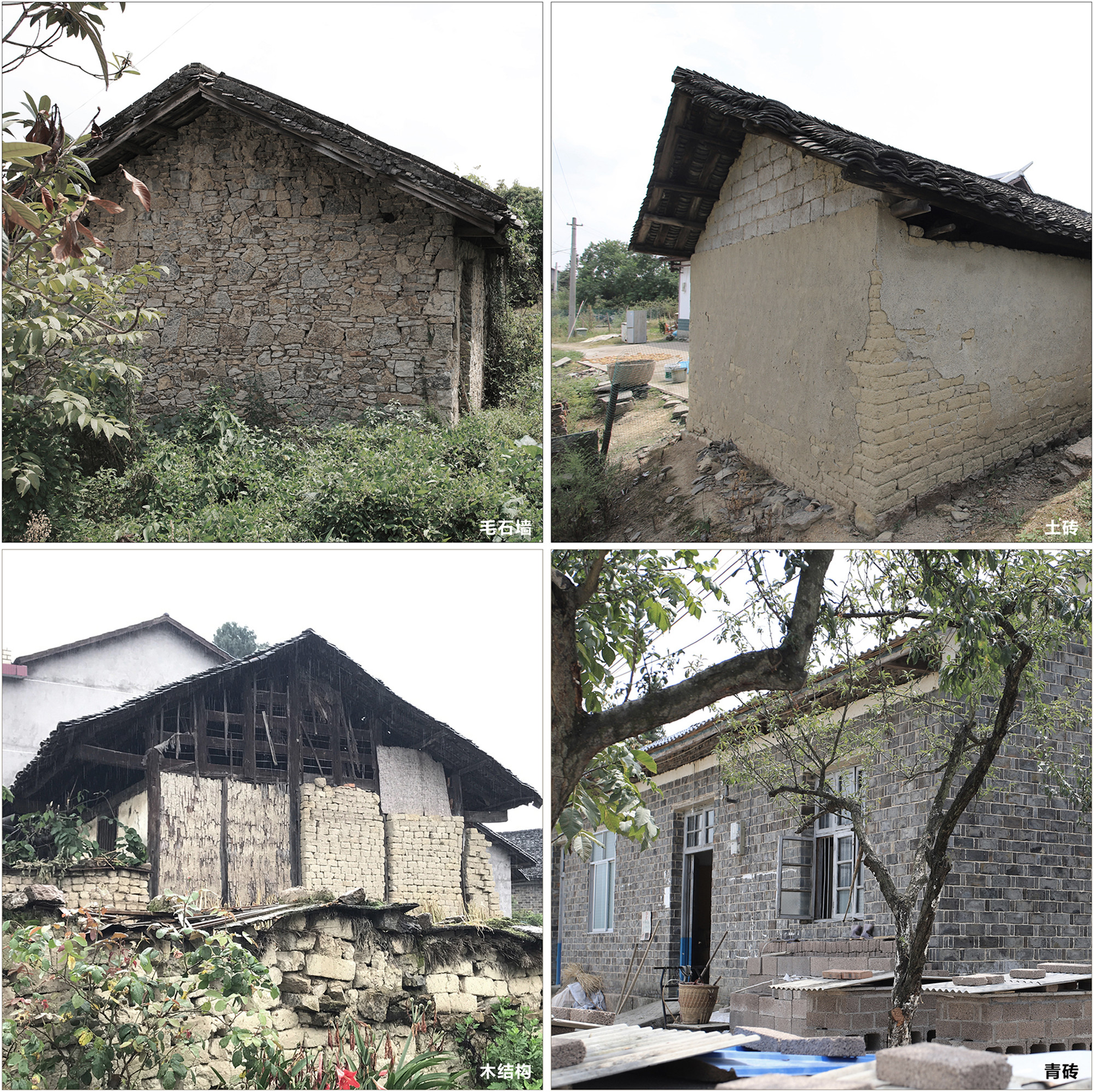
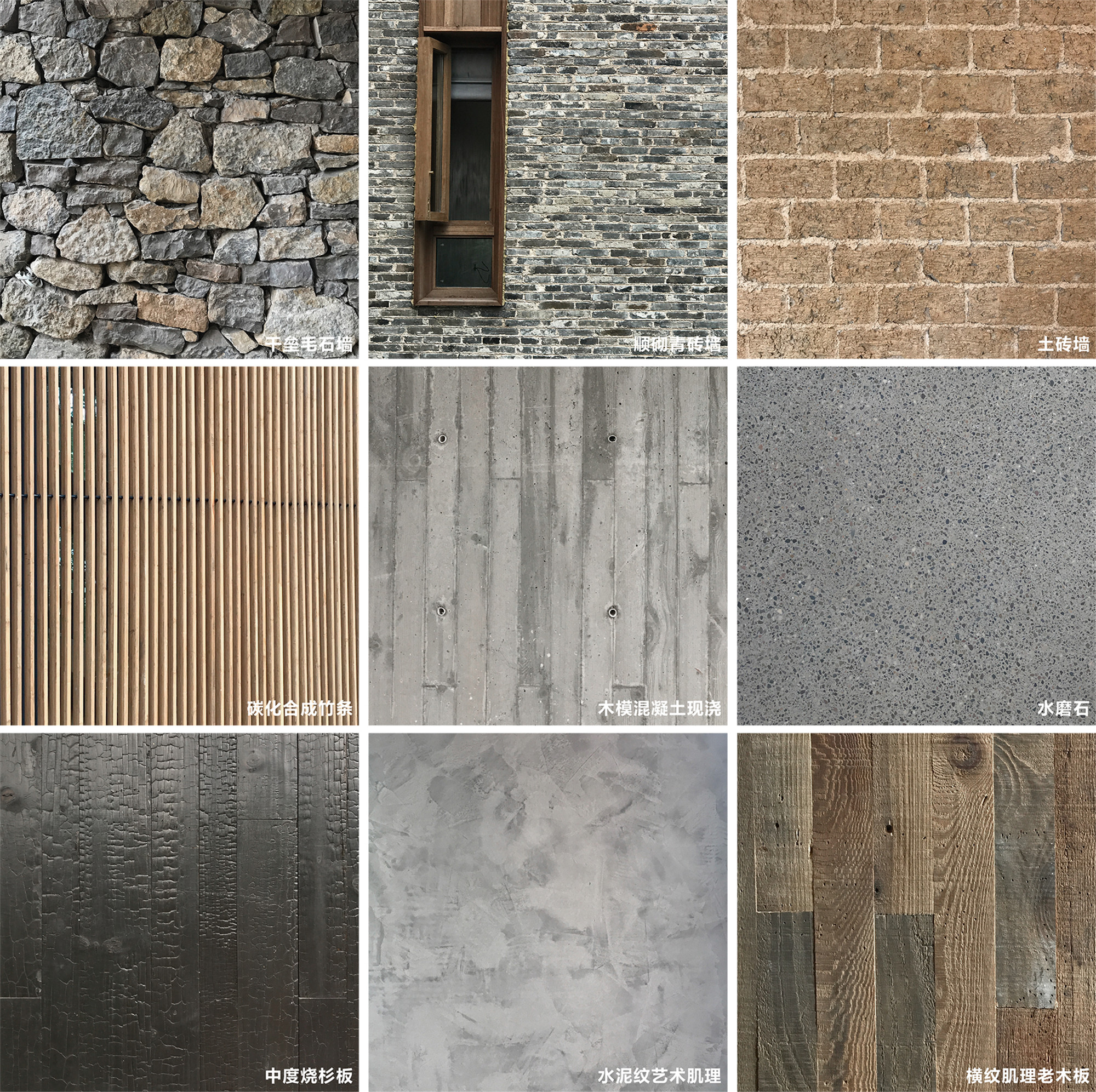
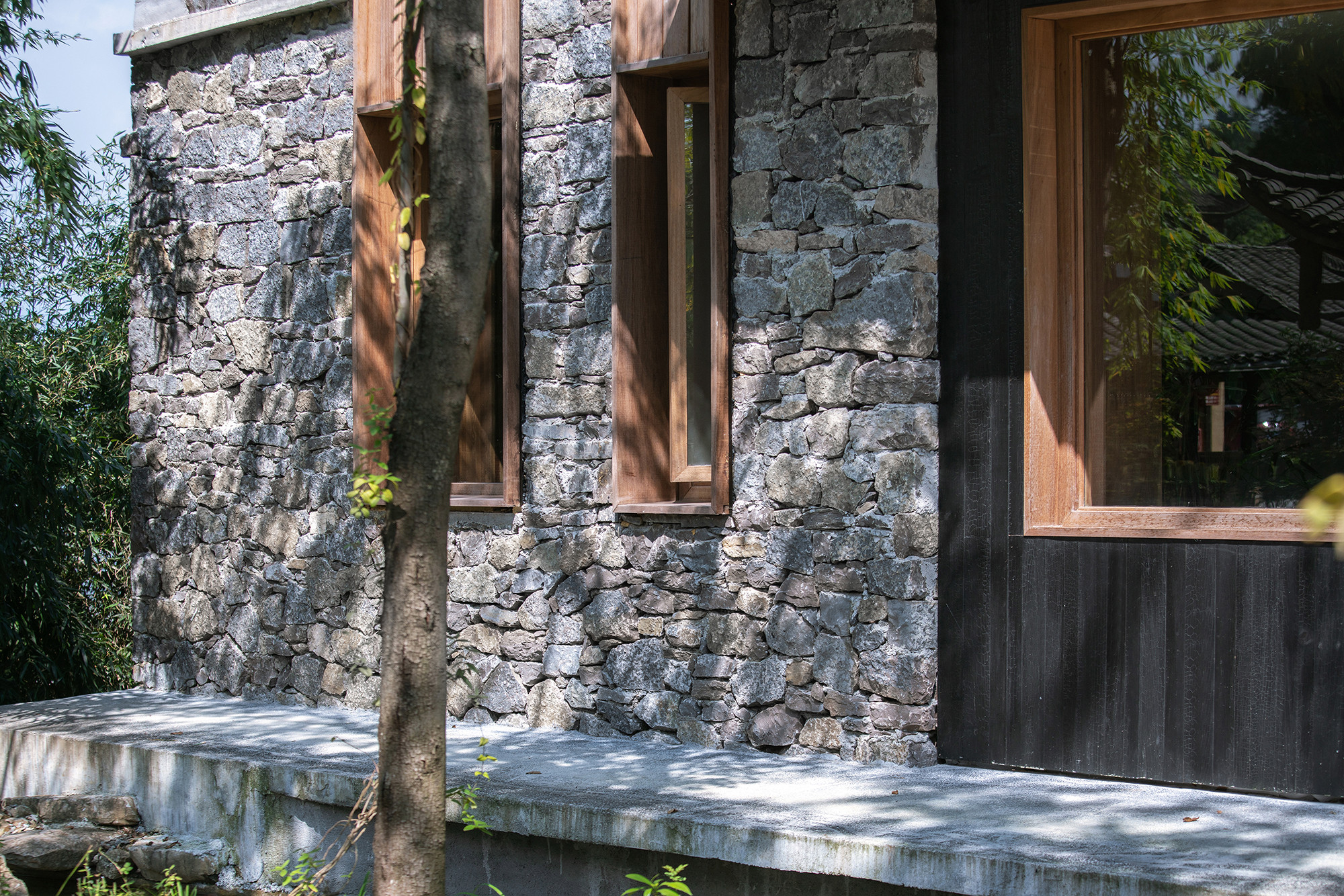

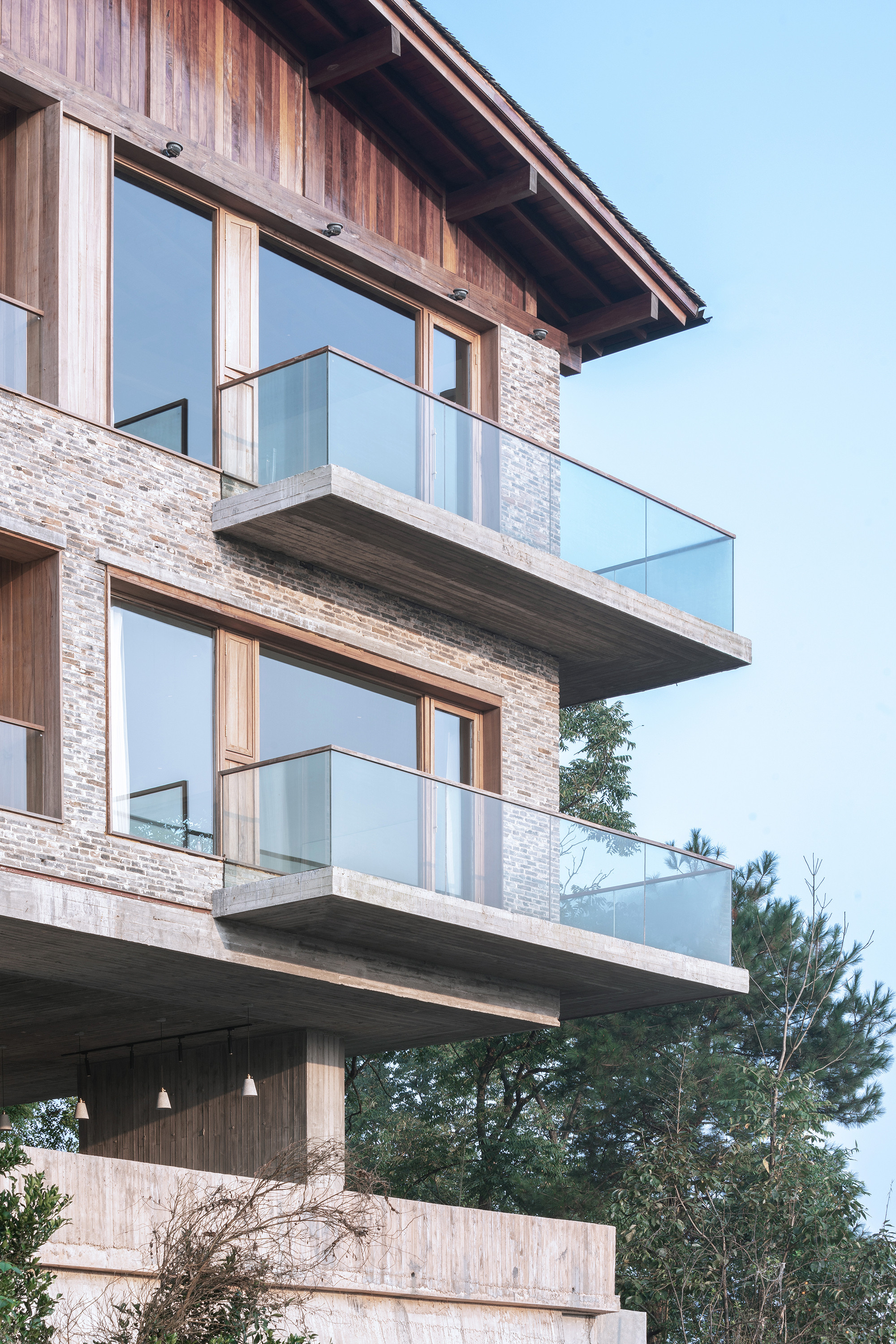
在结构的选择上,我们希望结构本身就是可以被表现的,是建筑空间和墙体体系的一部分,可直接被感知。混凝土用木模一次性浇筑,既是剪力墙结构,又是内外空间墙顶面,木纹和水泥质感即纯粹又能被直接触摸,而且可以实现无柱大开间空间,减少柱子的出现,实现空间自由。
In terms of structural design, we hope the structure is expressive, serve as an integral part of the building's space and wall system, and be sensed directly. Using the wooden mold cast-in-place concrete structure, the framework serves as the shear force structure while becoming surfaces of interior and exterior walls, with textured wooden finishes and concrete casted finishes that feel pure and welcoming to touch. The wooden mold cast-in-place concrete structure creates a column-free large-bay structure, allowing interior spacing without constraints.
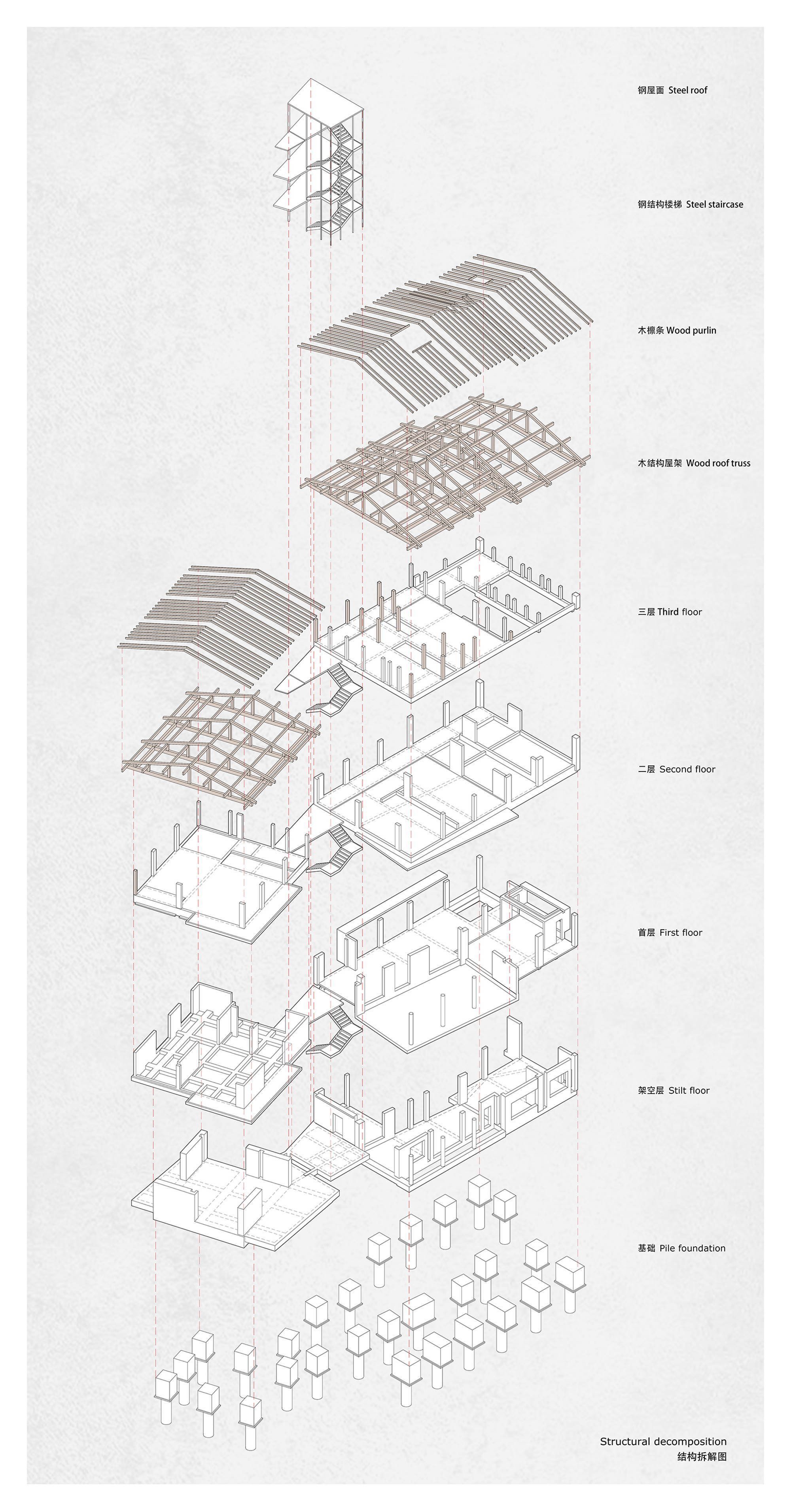
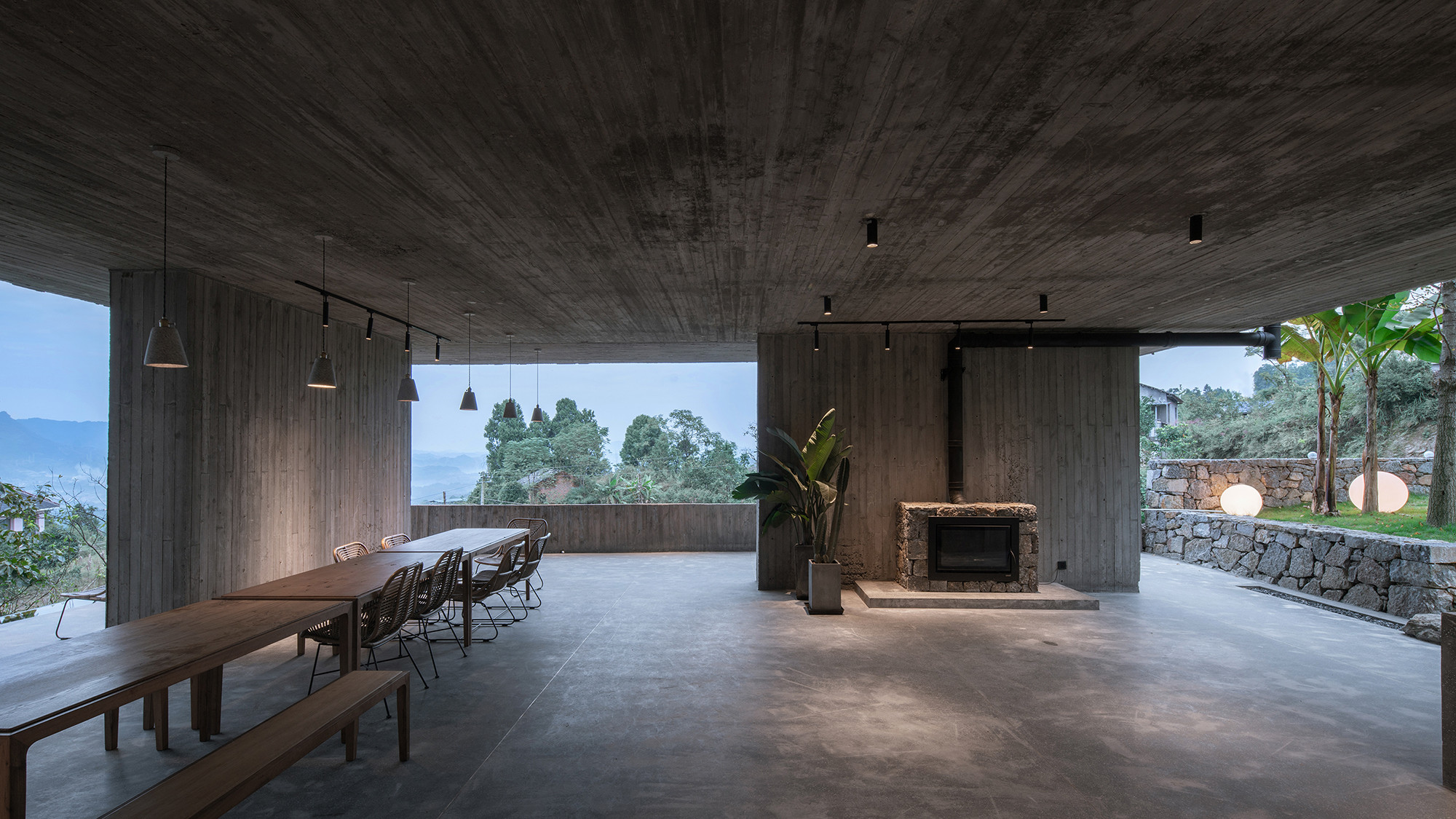
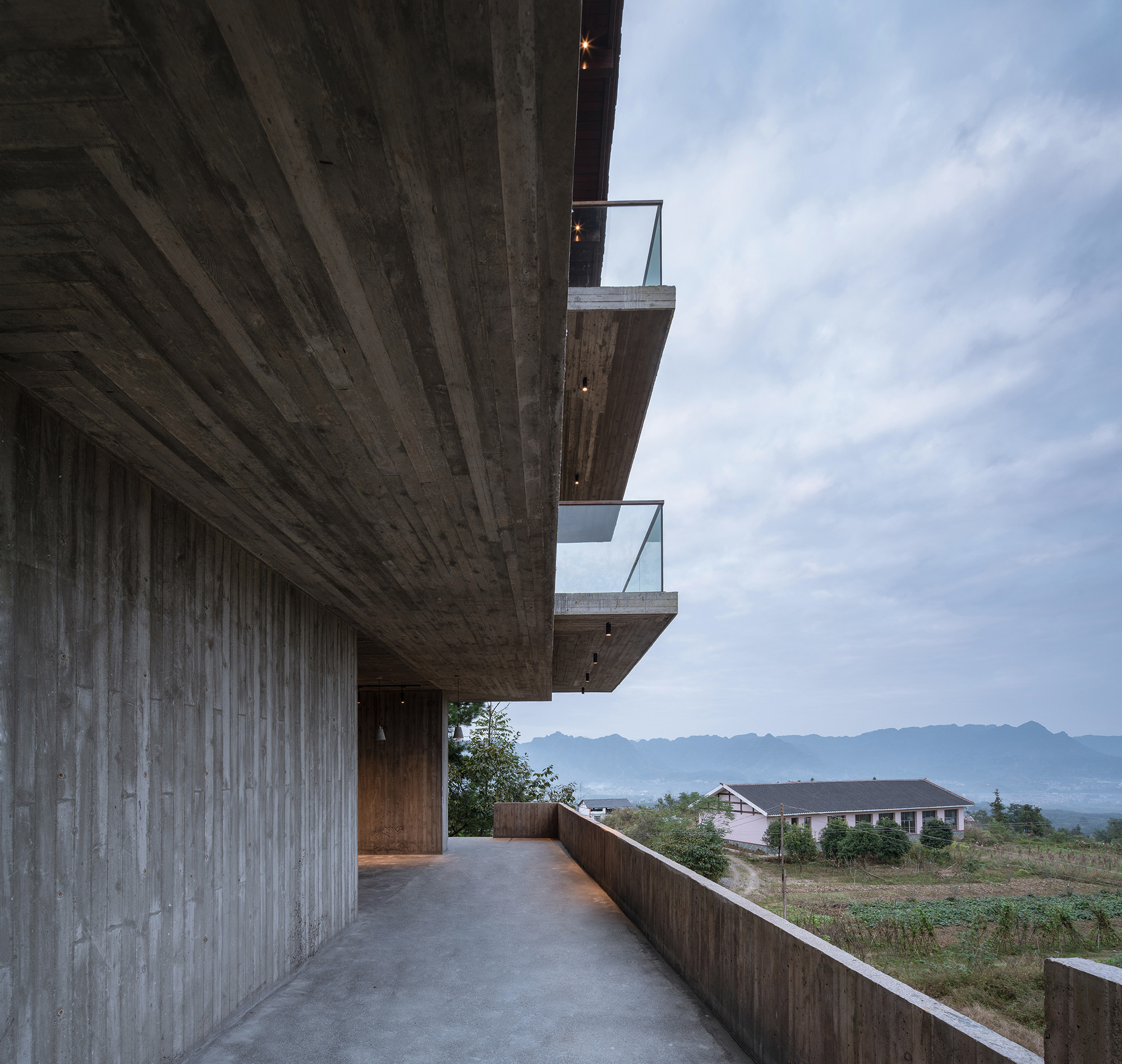
木构在当地传统建筑中被广泛使用,建筑的上半部分使用纯木构,与剪力墙结构体系咬合,木构杆件在室内空间中直接裸露,无二次装饰面层,结构材即空间面材,所有电线都走在屋顶保温层空腔里,将建筑结构和室内效果达成了完美结合。
Wood structure, being widely utilized by local houses, is used at the upper section of the residence, interdigitating with the shear force structure. Wooden structural beams are exposed within interior spaces without any other decorative surface, as the wooden structure itself serves as the interior surface material. All electric wiring is concealed within the thermal insulation located at the roof to integrate the building structure and the interior design optimally.
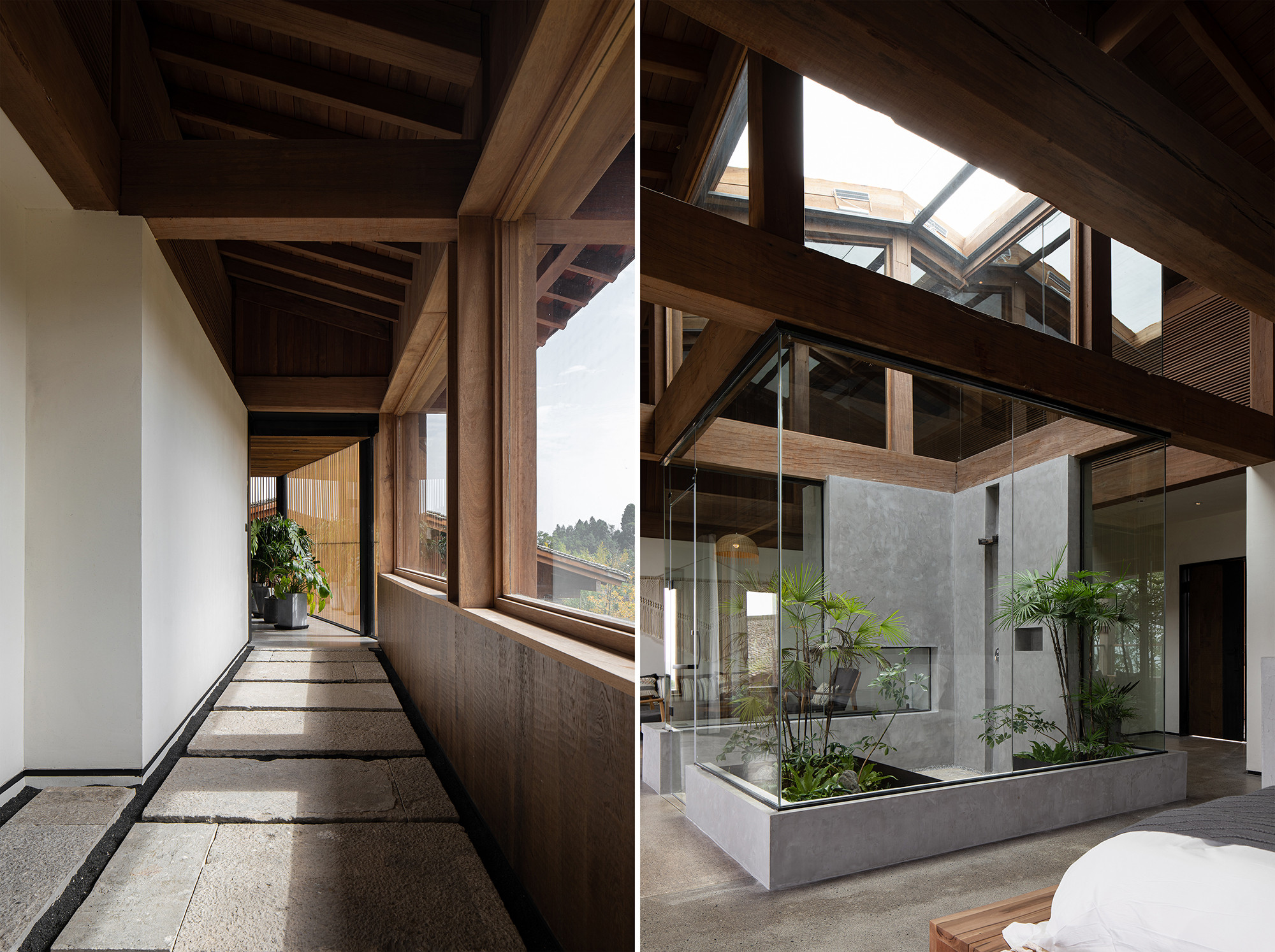
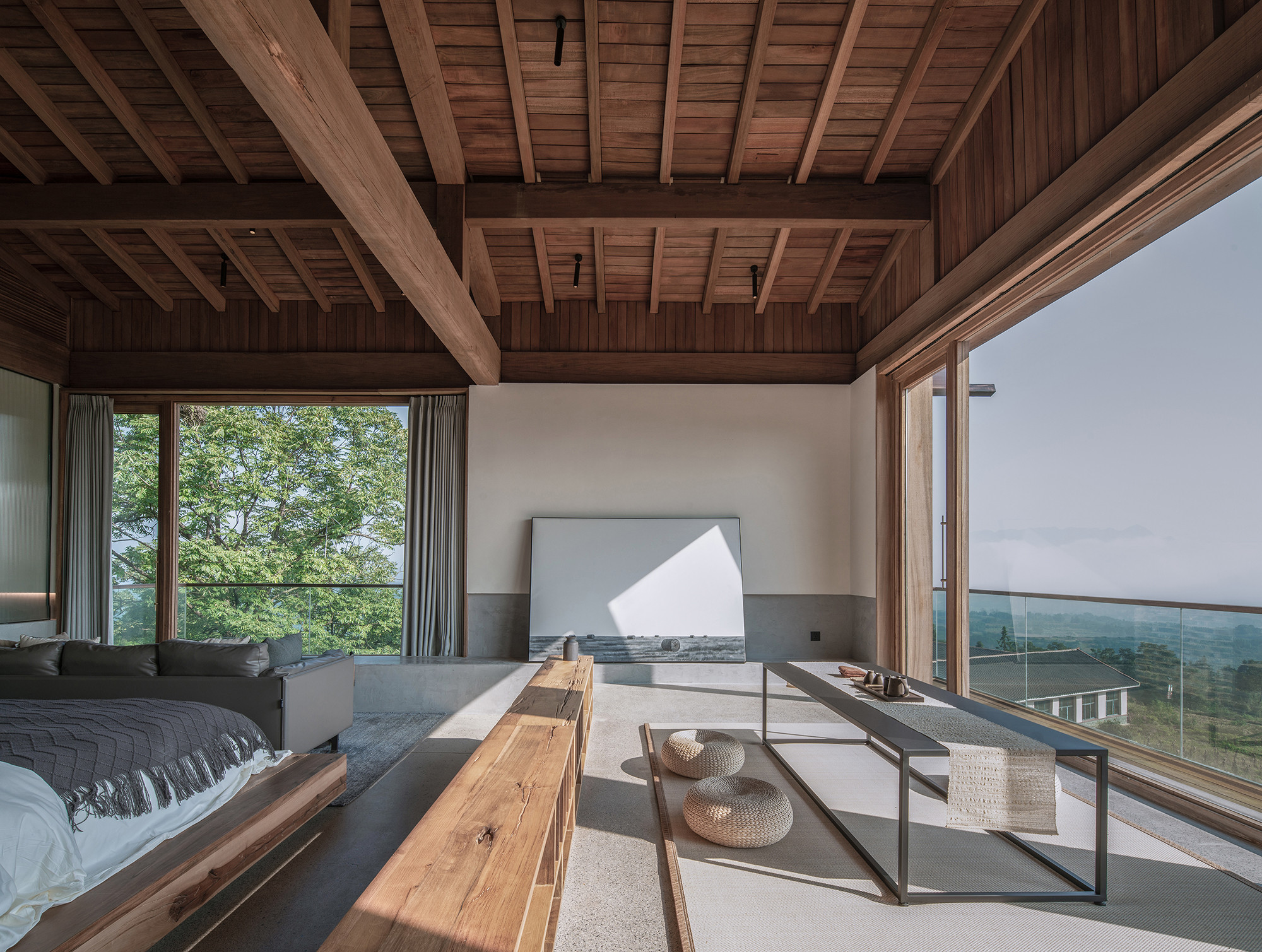
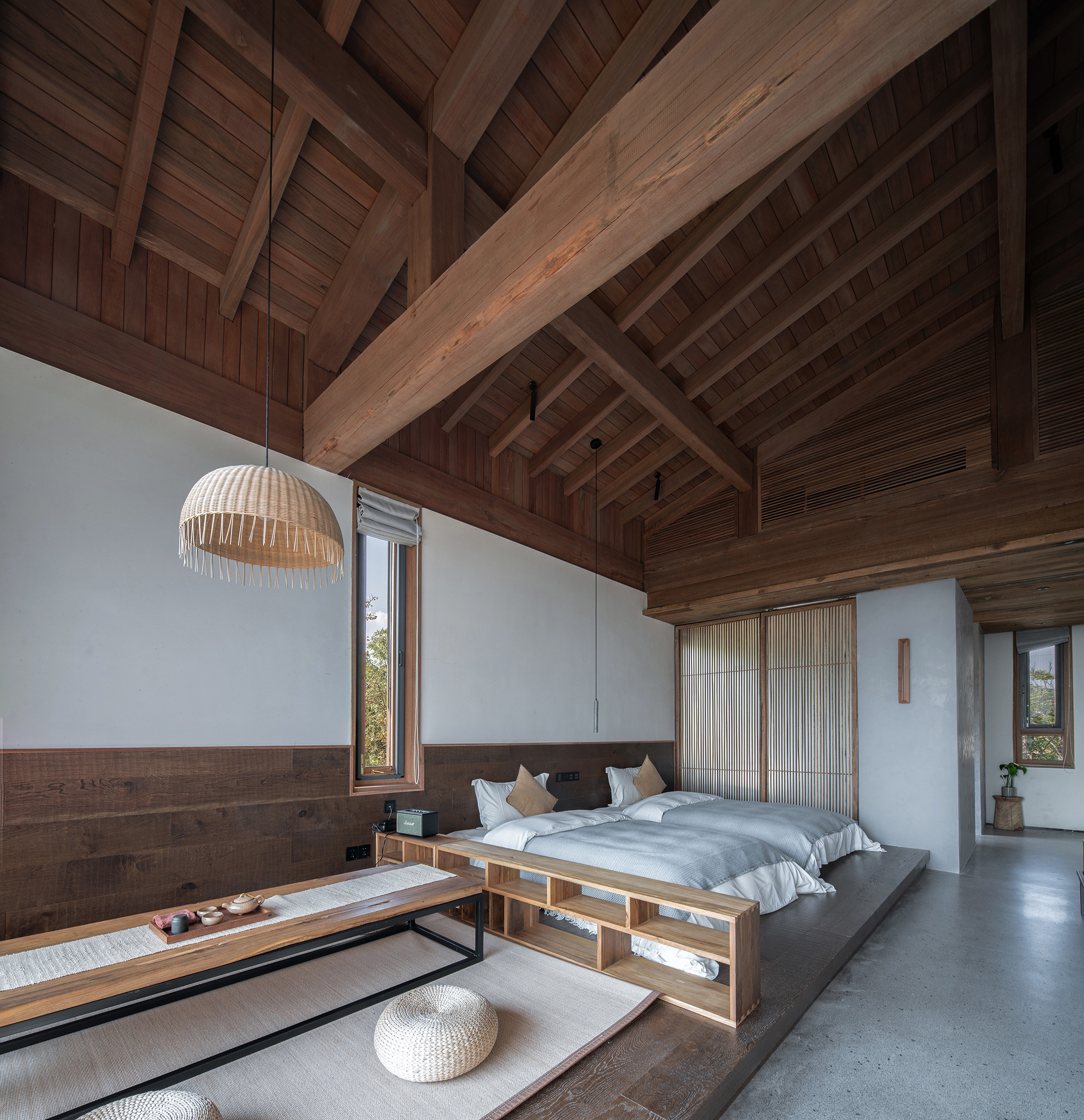
理解精确性
我们总是会面临这样的问题:如何去化解传统建造和现代设计的矛盾?如何让工匠理解图纸?如何让看似零散的材料组织成空间?我的回答是重视对精确性的控制。精确不等同于精致,精确在我看来可以被理解成一种感知,一种内在的控制逻辑,可以用语言传达,可以被训练,但不一定能用图纸完整表达。精确可能是抽象的,在建造中与用心感受,精确则会被放在很重要的位置。
We are always perplexed by concerns like, "how to resolve the inherent contradiction between traditional construction and modern design"; or "how to form space with materials seemingly fragmented?" Our answer is the importance of accuracy control. Accuracy is not equivalent to delicateness, as accuracy can be perceived as a sensation, an inherent logic of control. Accuracy as a concept can be delivered through language and enhanced through training. However, it may not be fully expressed through construction drawings. Accuracy can be seen as an abstract concept. During construction processes, the feeling and understanding of accuracy should be seen with a high priority.

比如我会跟垒石的工匠师傅说:垒石头的时候,自然面外露,无需水泥勾缝,水泥砂浆退进毛石墙面三公分,石墙整体关系下大上小,大小石块穿插垒砌,无需挑选颜色,1.5米间方用拉钩与内墙体拉结。景观墙体用大于建筑墙体1/3大小的石块垒砌。工匠师傅基本能做到这句话的要求,也就算是精确了。
As an example, I will inform stone stacking craftsman that: "during the stone stacking process, make sure always to expose unprocessed sides of stone chunks, no filling up gaps with cement, the cement mortar retreats three centimeters into the rubble wall, maintain the bottom heavy shape of the stone wall, intersperse large and small stones during the stacking, no need to choose the color, use hook to tie with the inner wall for evert 1.5 meter square of area, and stones used for constructing landscape wall should be larger than 1/3 the size of stones used for structural wall construction." If the construction workers could fulfill those requirements mentioned, they would have successfully met the accuracy requirement.
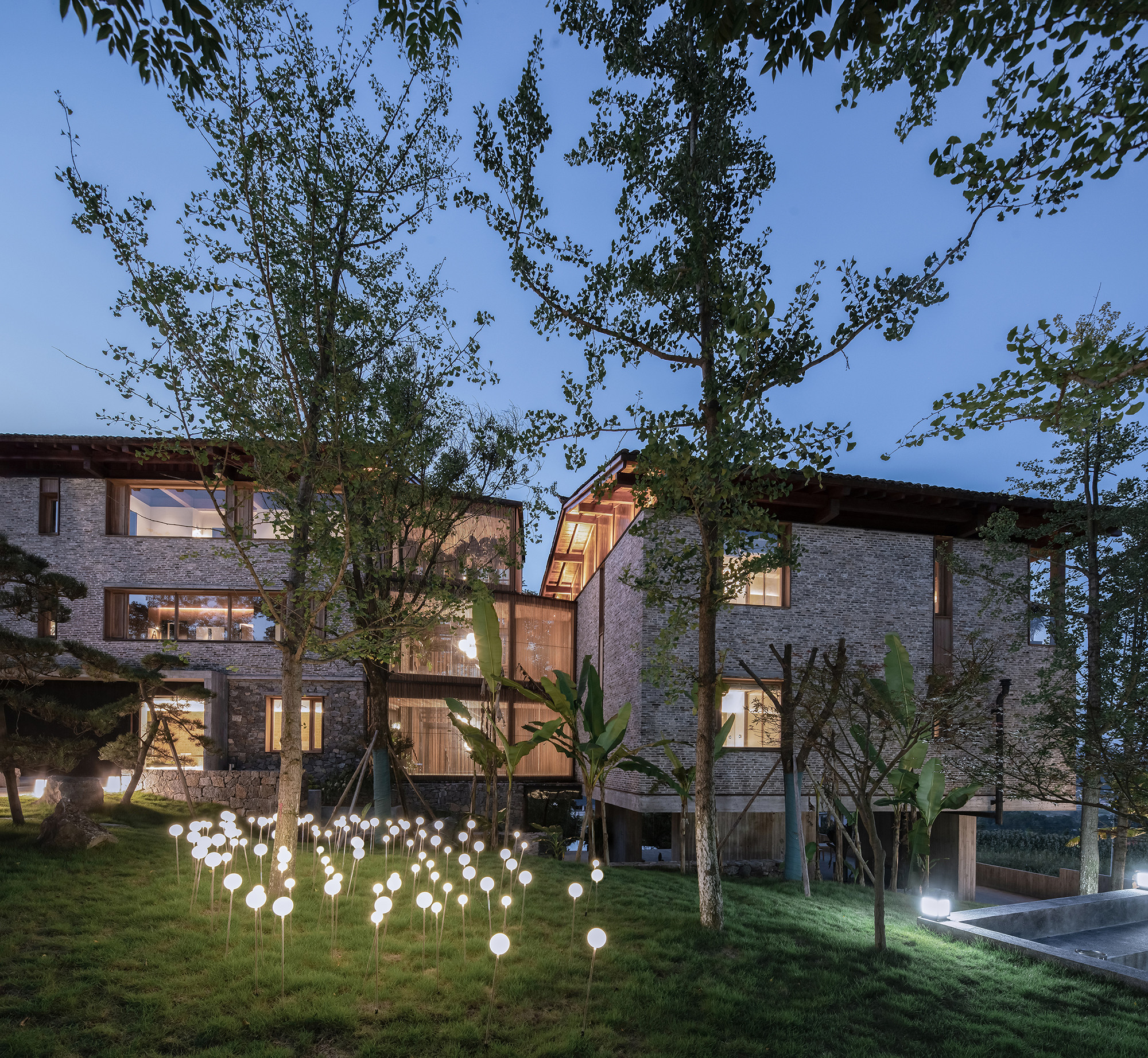
一体化设计的实现
这次是一次相对综合的一体化设计实践,涵盖了项目定位策划、区域规划、建筑、室内、软装、景观、灯光、结构、水电暖、智能、标识导视全专业、全系统、全过程的整体设计,全盘考虑,一体化设计落地,形成建筑与室内空间的连贯性,硬装和软装搭配的完整性,建筑跟景观衔接的延续性,结构与材料关系的统一性,各方面在图版和实践中做到比较好的配合。
This project is a comprehensive experiment of an integrated end to end design, consisting of project positioning and planning, site planning, architecture design, interior design, decorative design, landscape design, lighting design, structural design, piping and electric system design, smart furniture integration, visual guide system design. It is a project that requires cross-professional, cross-system, and end-to-end integrated design. With such a level of vertical integration, the coherence between the exterior design and the interior design, the unity of building structure and decorative designs, the continuity of the building design and the landscape design, and the conformity of structure and construction materials can all be guaranteed.

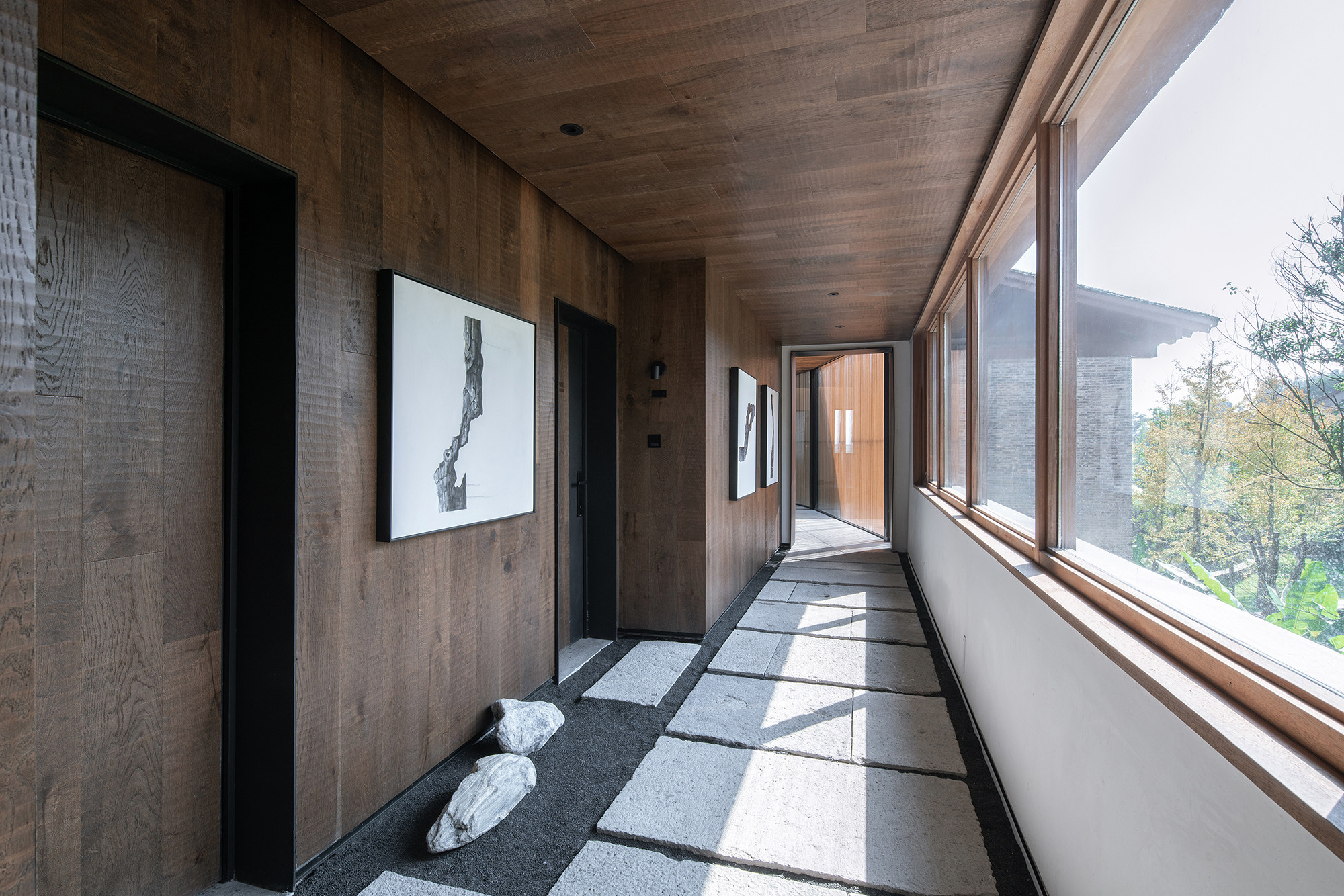
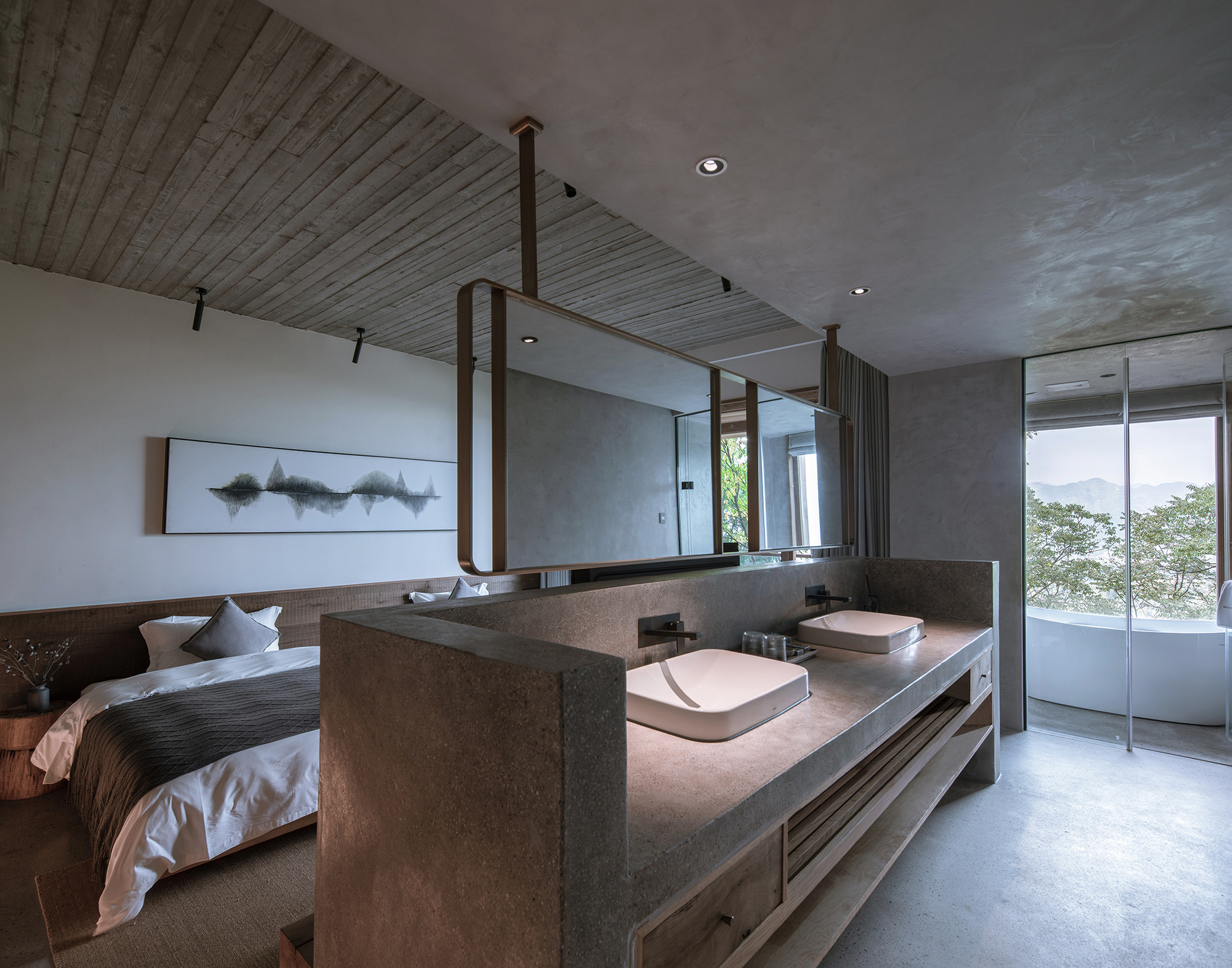
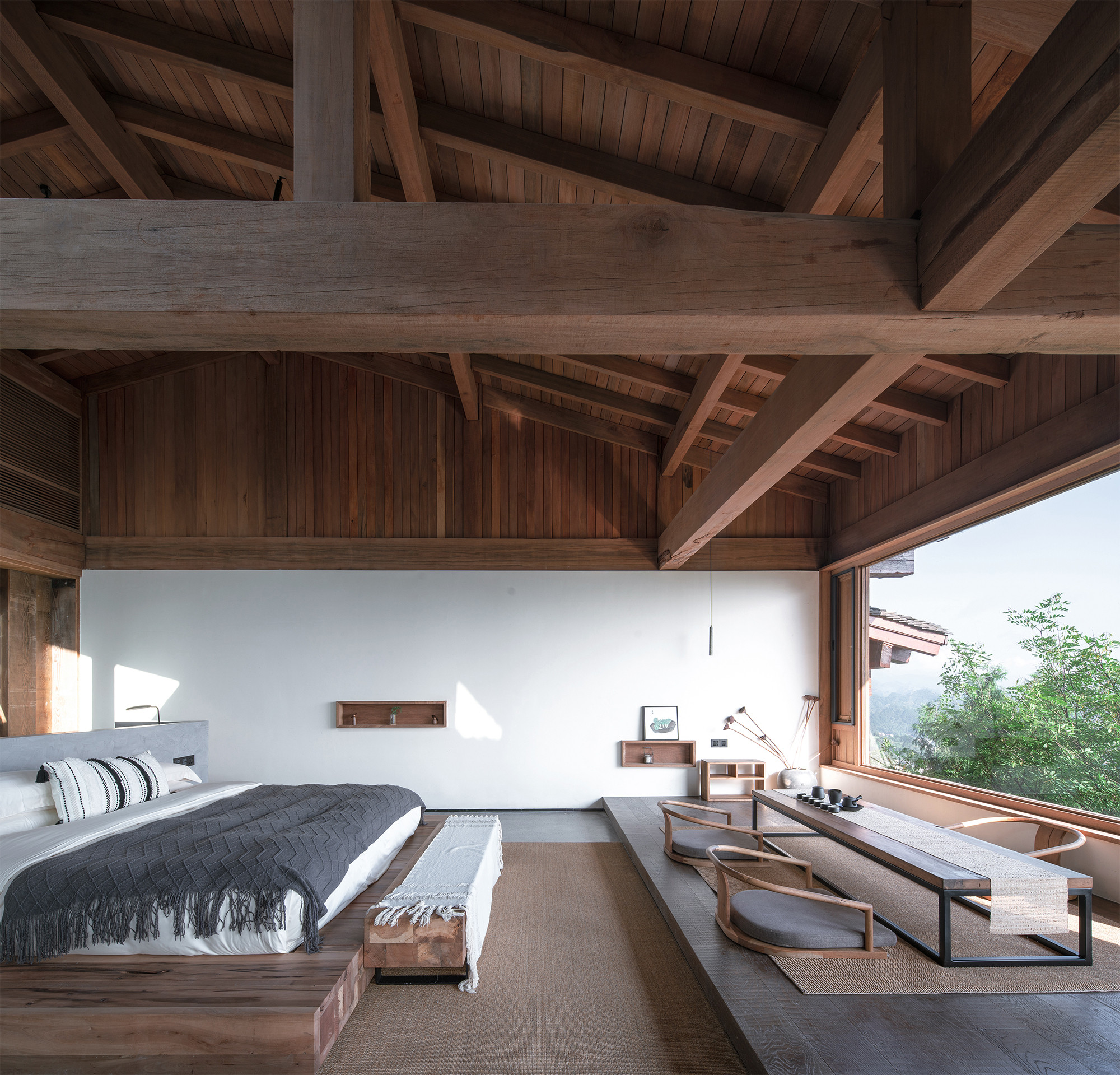
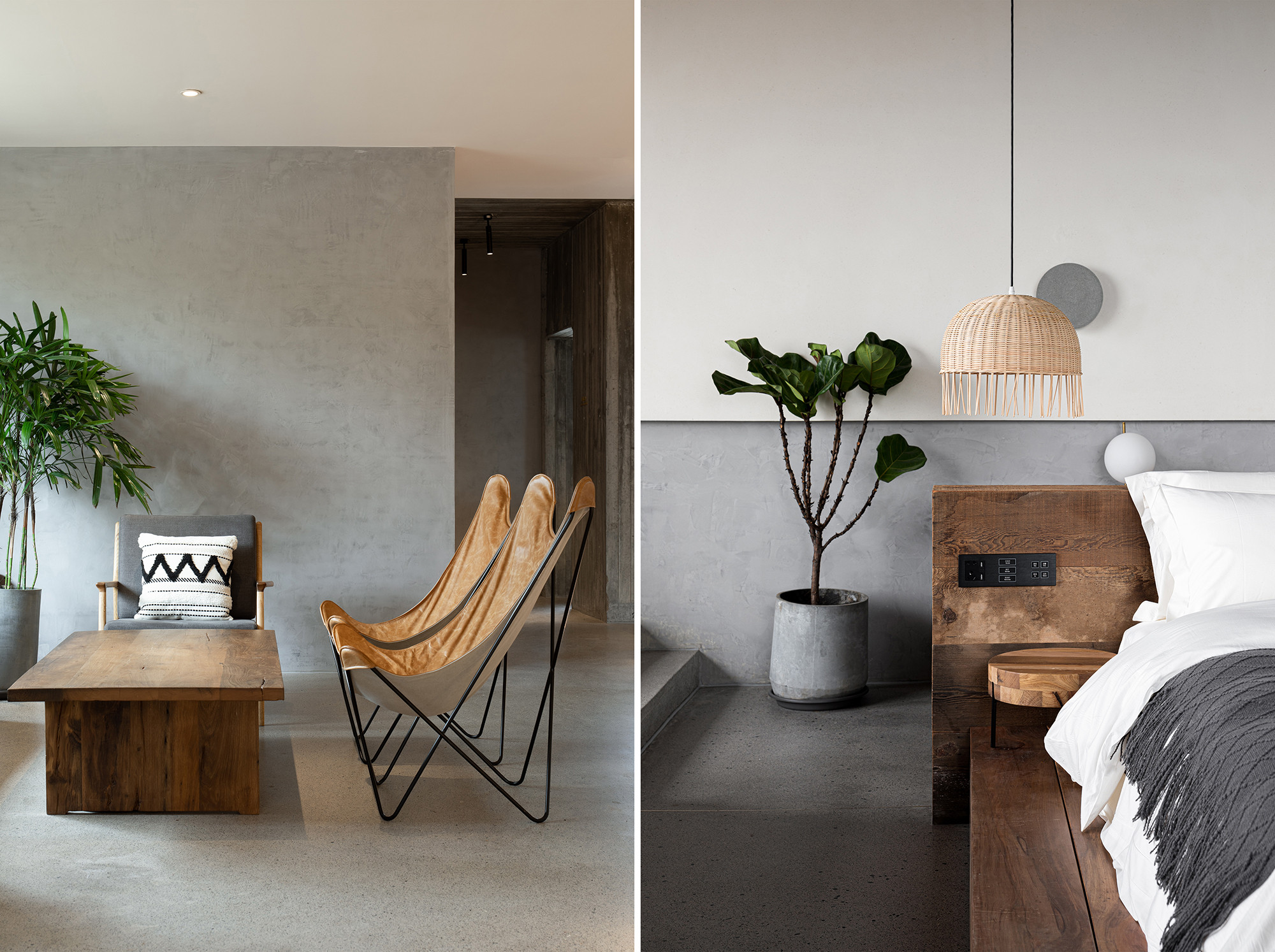
这也减少了很多施工过程中各专业各工种的矛盾冲突,大大缩短了项目的施工周期,建筑室内景观施工紧密衔接,节省了大量的造价成本。同时一体化的设计过程保证了设计语言系统的完整,材料体系的贯穿,实现室内外自然过渡,创造了空间的完整体验,最后呈现出统一的空间效果。
Different fields of the project were being coordinated swiftly during the practice, hence reduced possible conflicts and clashes between different types of works during the construction, abled interior and landscape construction to have a smooth transition, significantly saved the construction cost, and shortened the overall construction periods. Meanwhile, the integrated design process also ensures consistent design language and material usage throughout every aspect of the project, making sure the natural transition from interior space to outdoor space creates a coherent and immersive environmental experience.
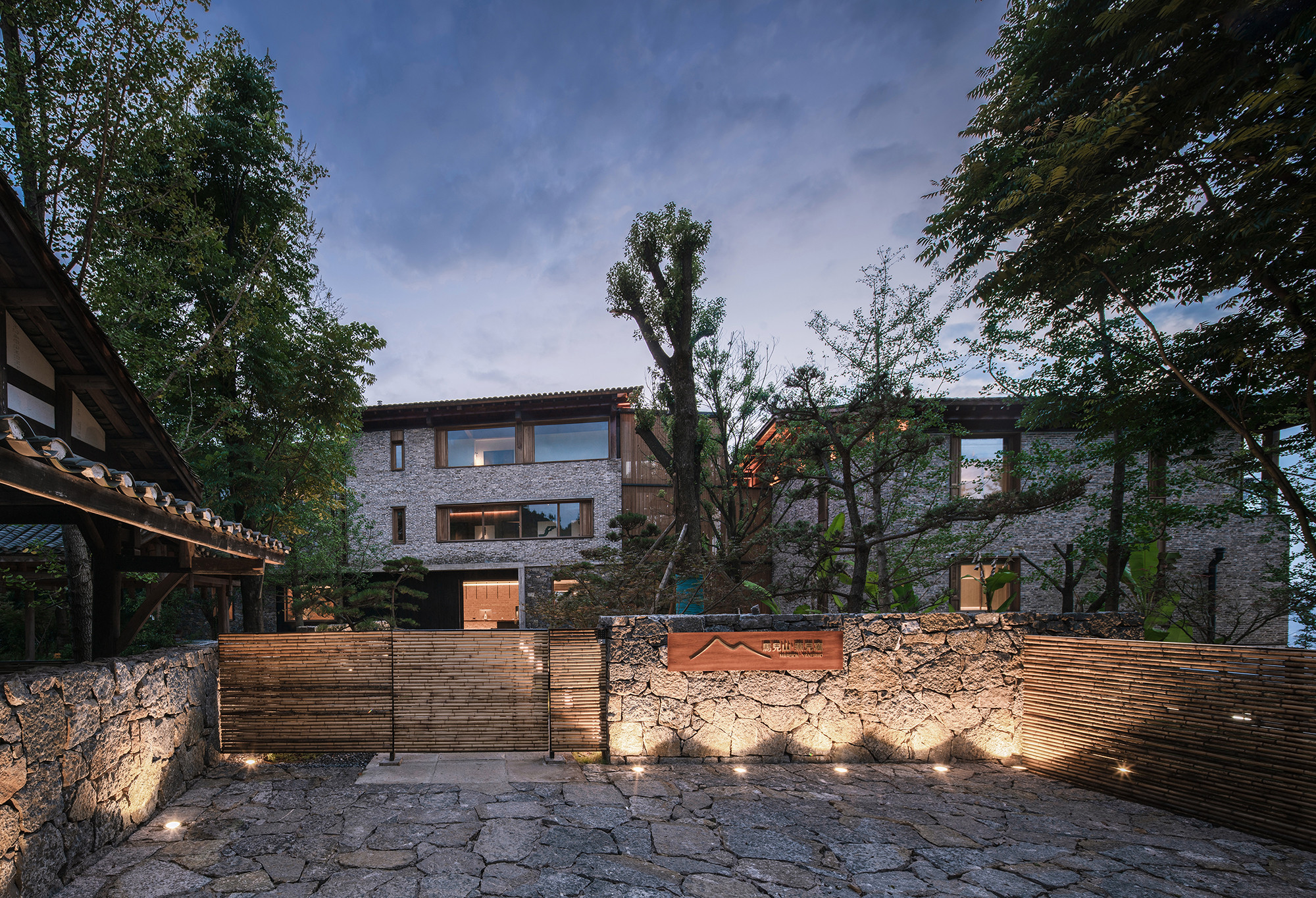
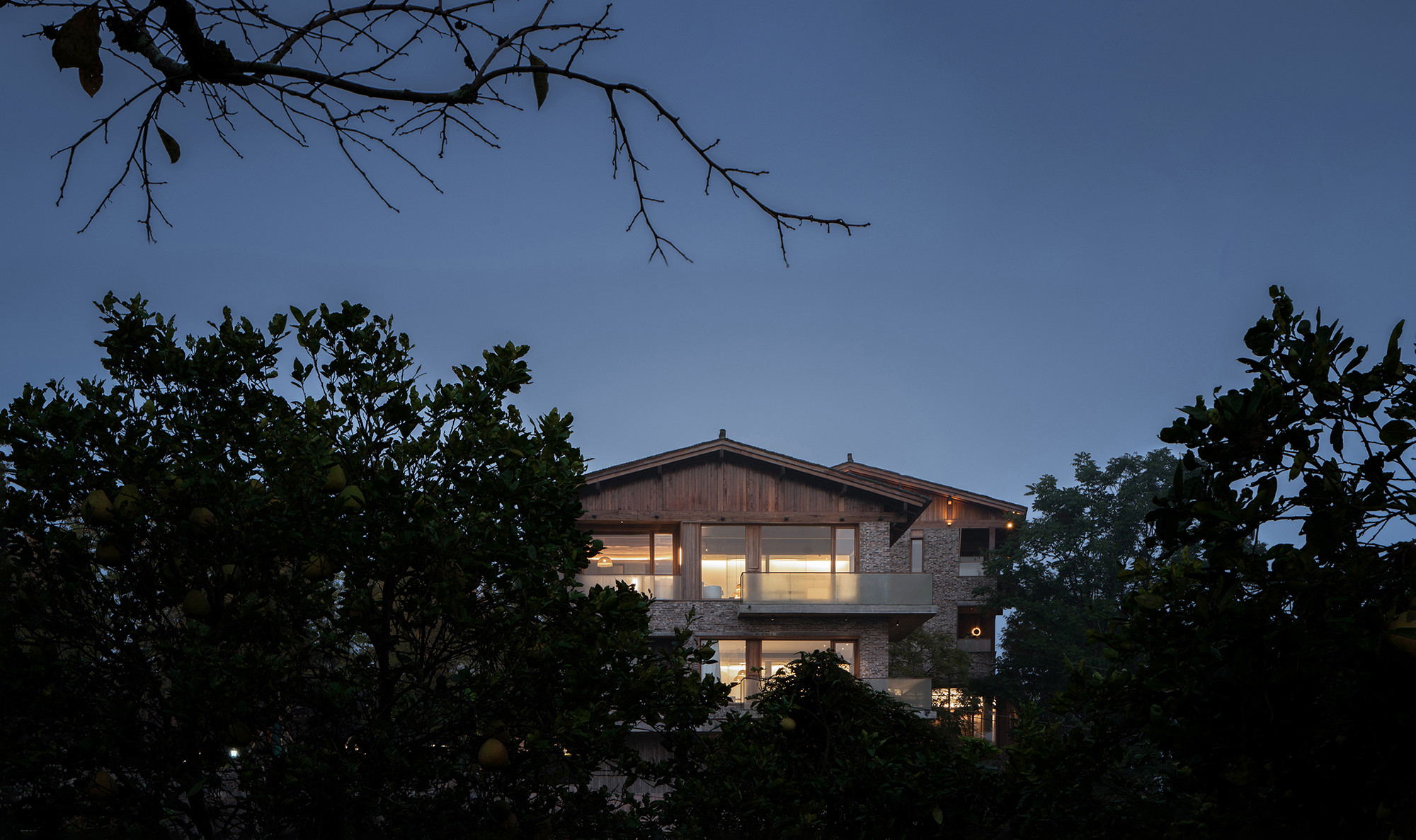
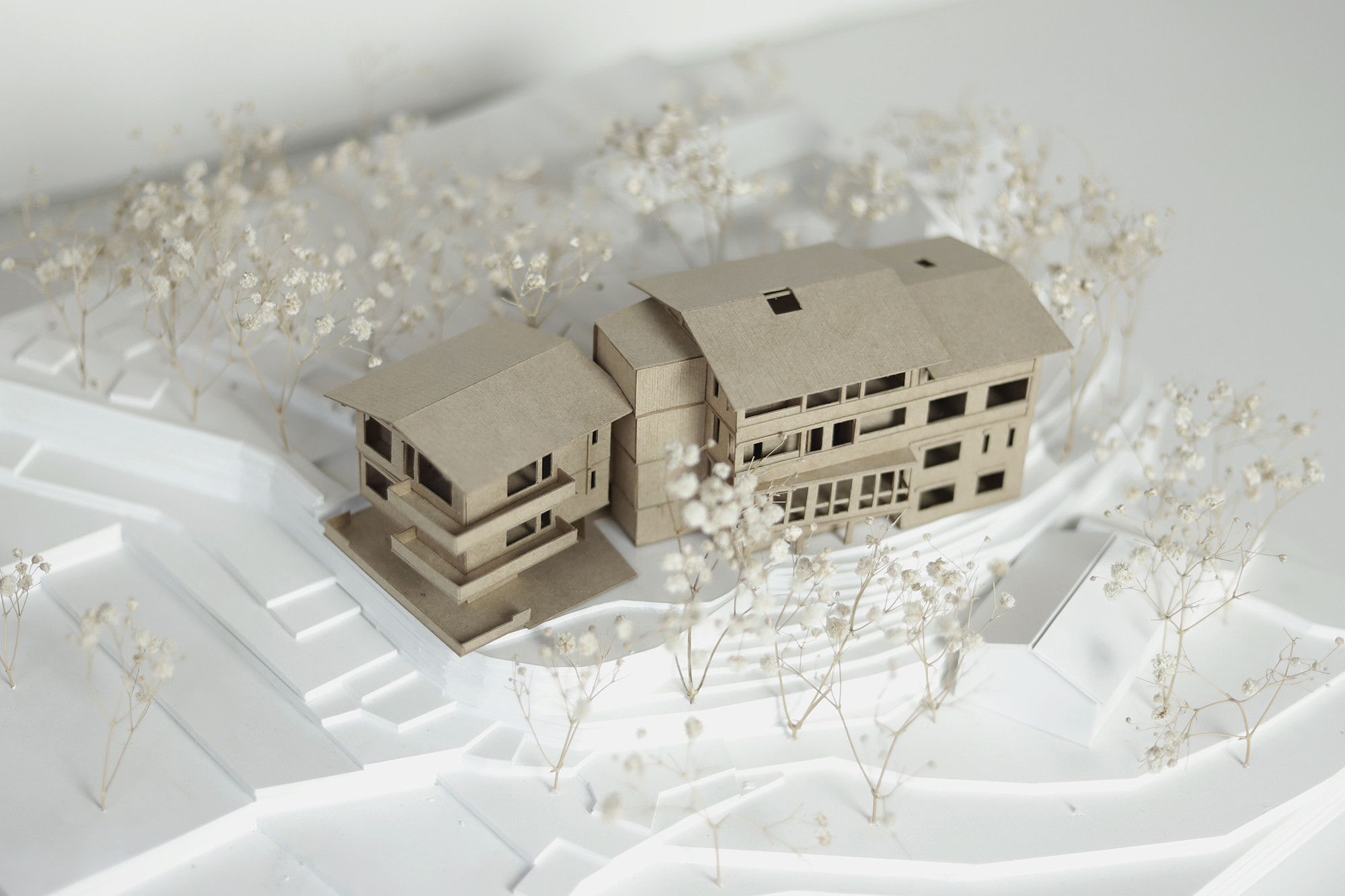
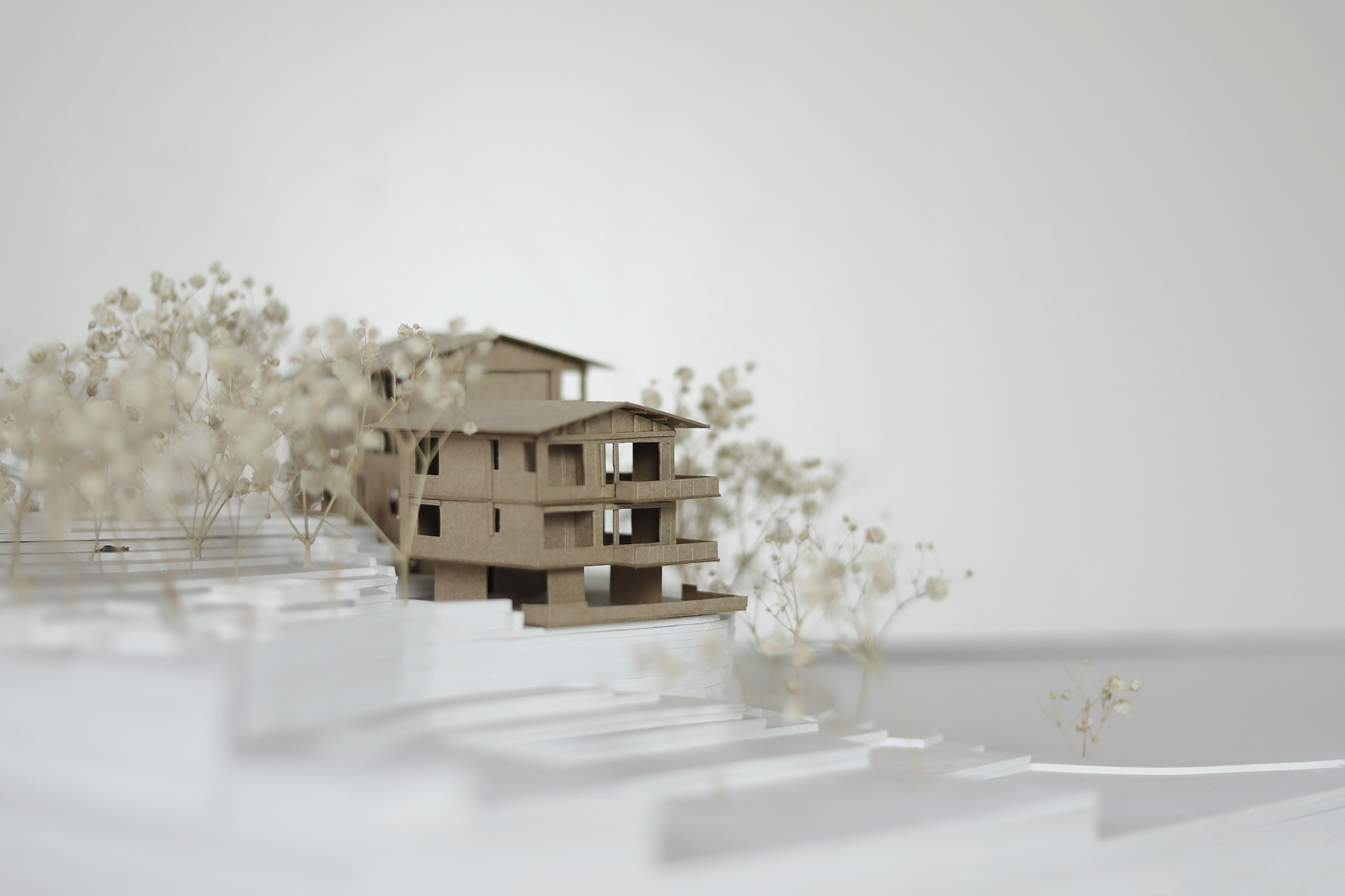
设计图纸 ▽
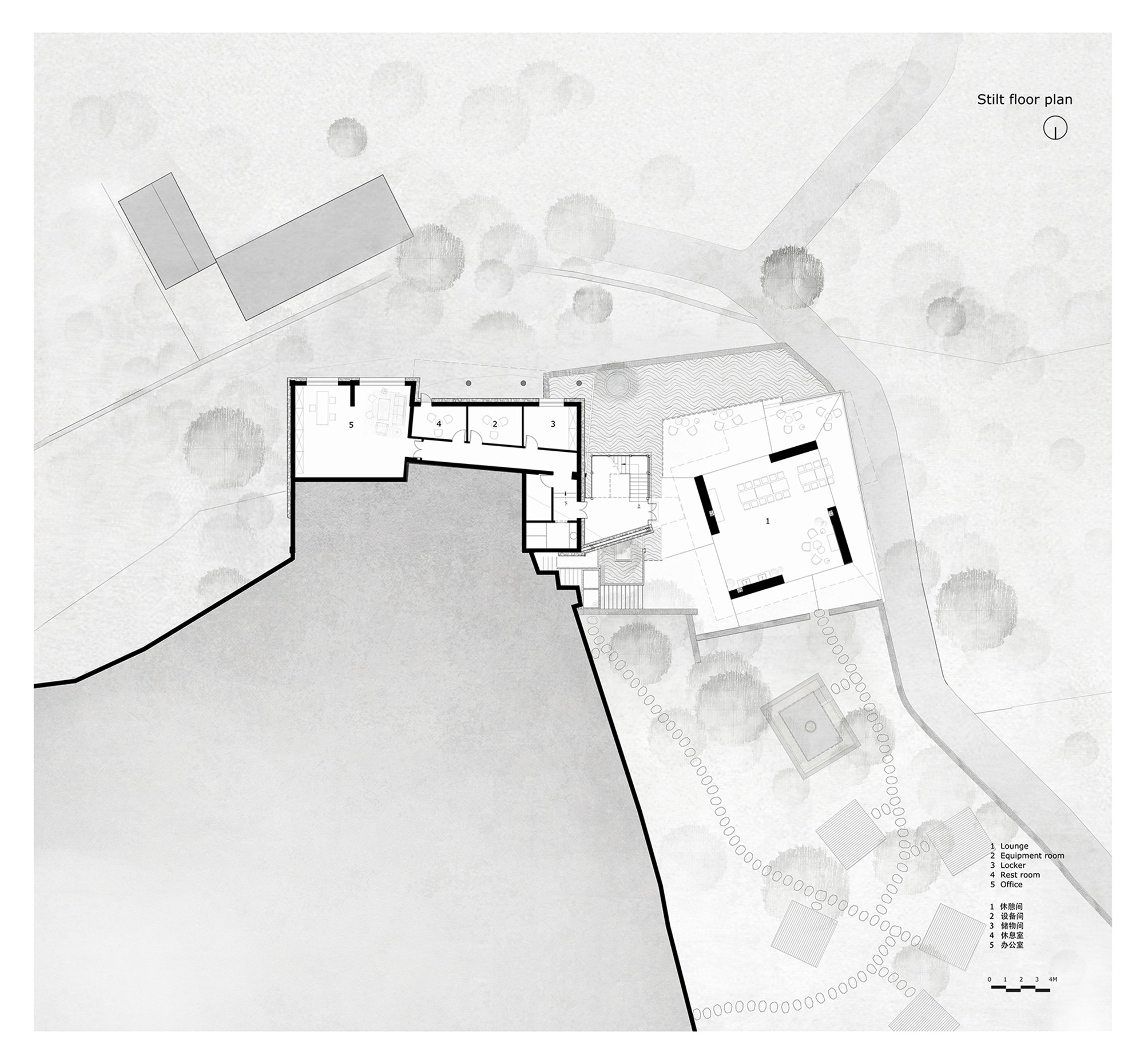
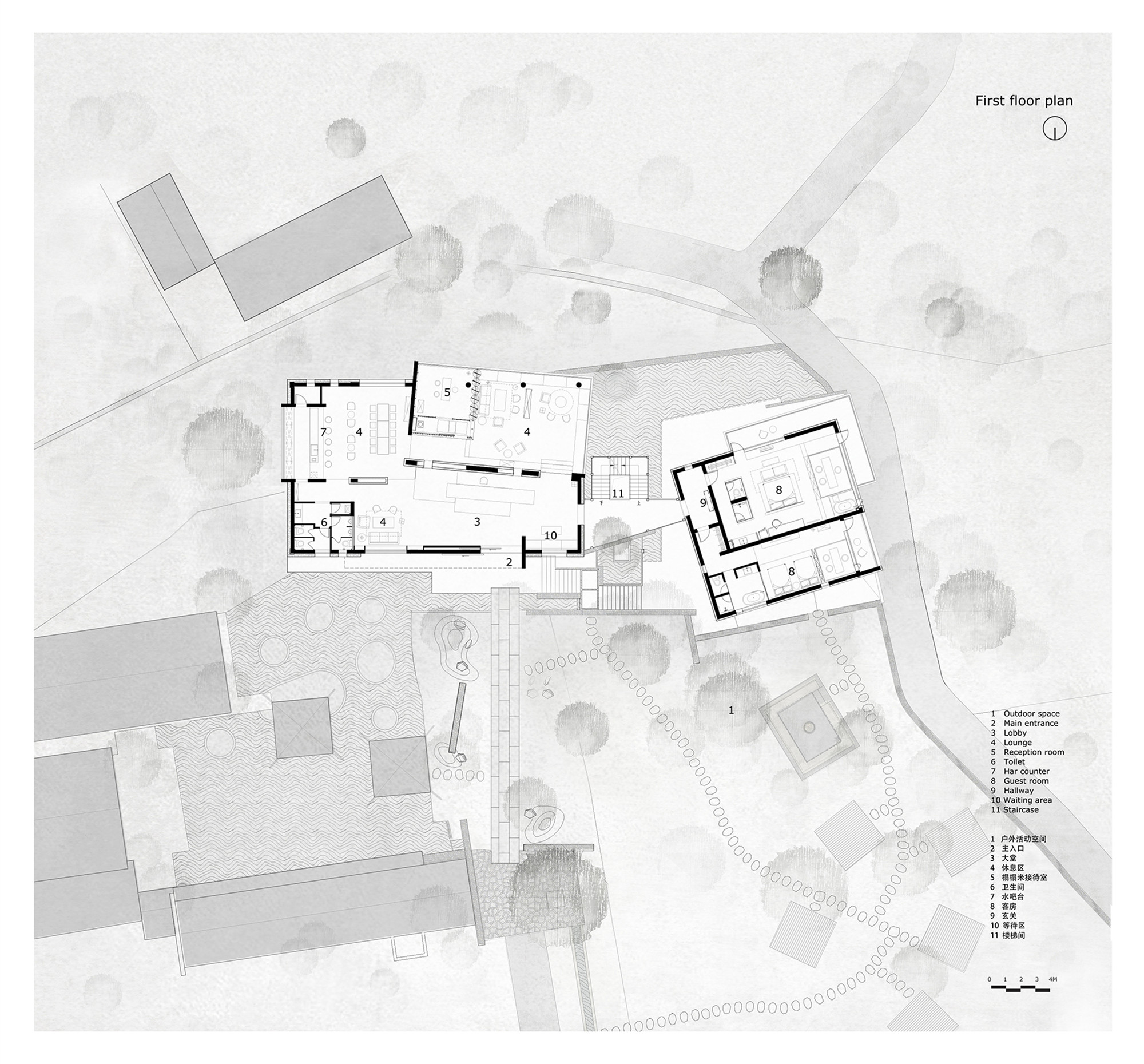
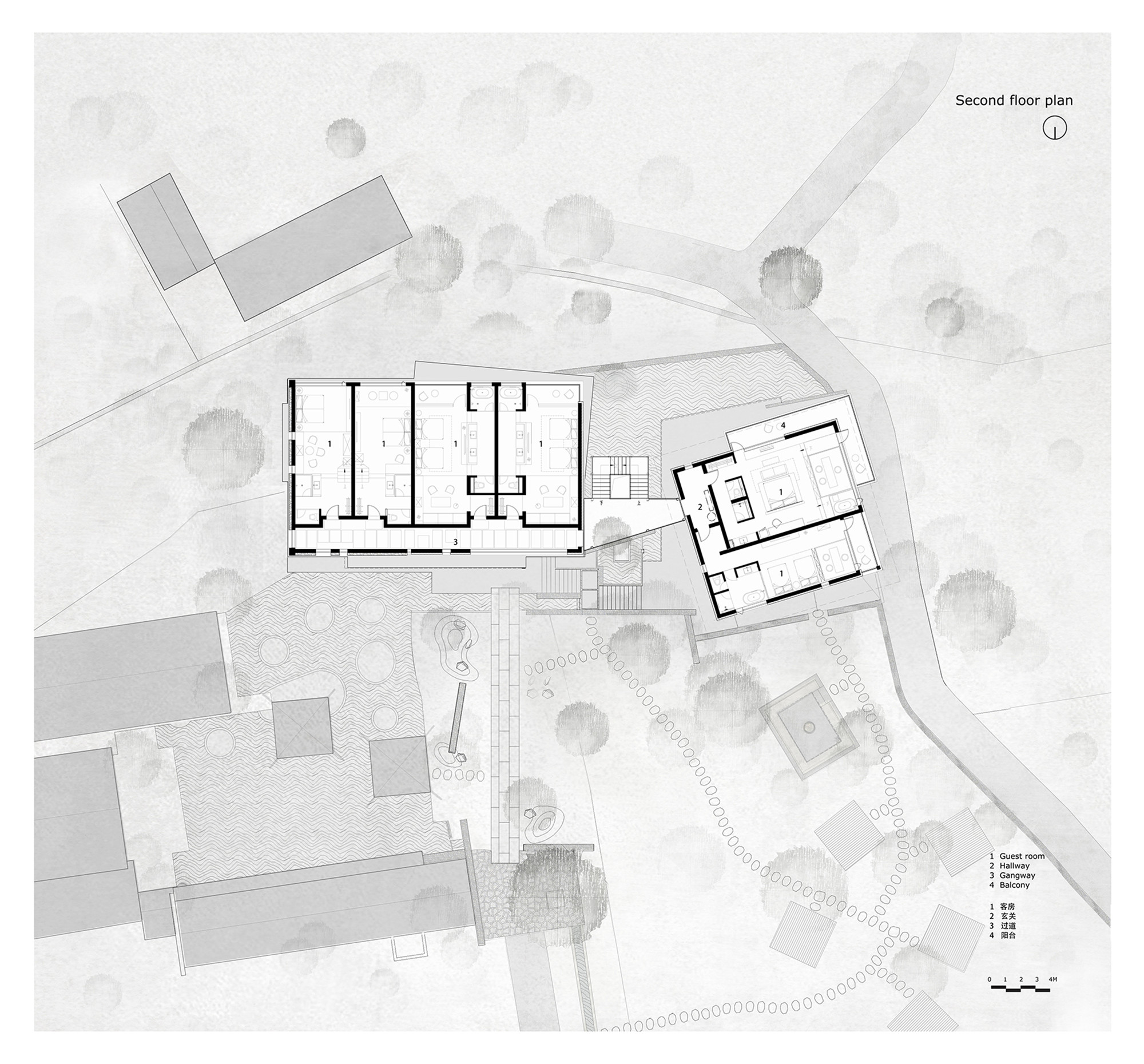
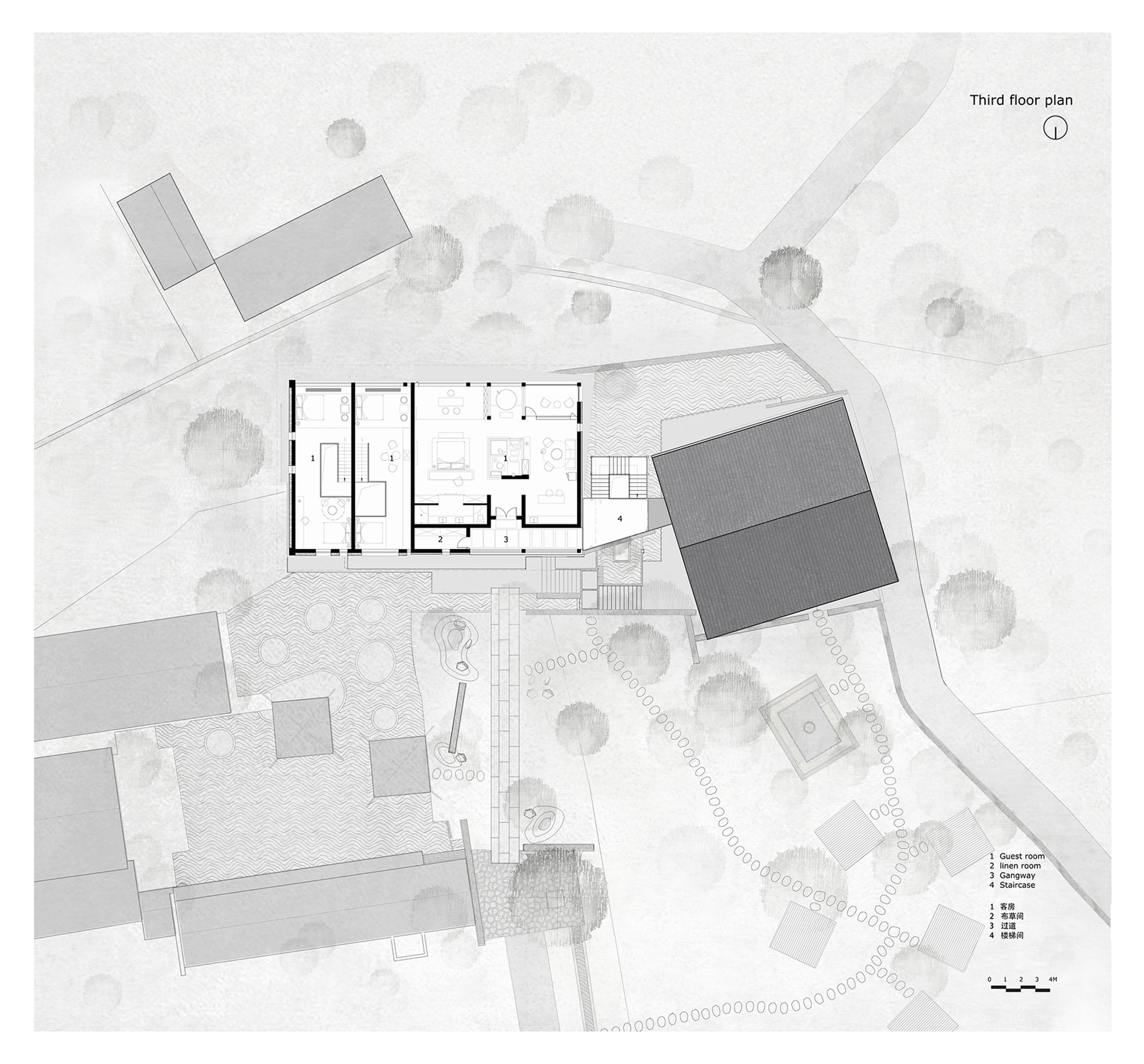
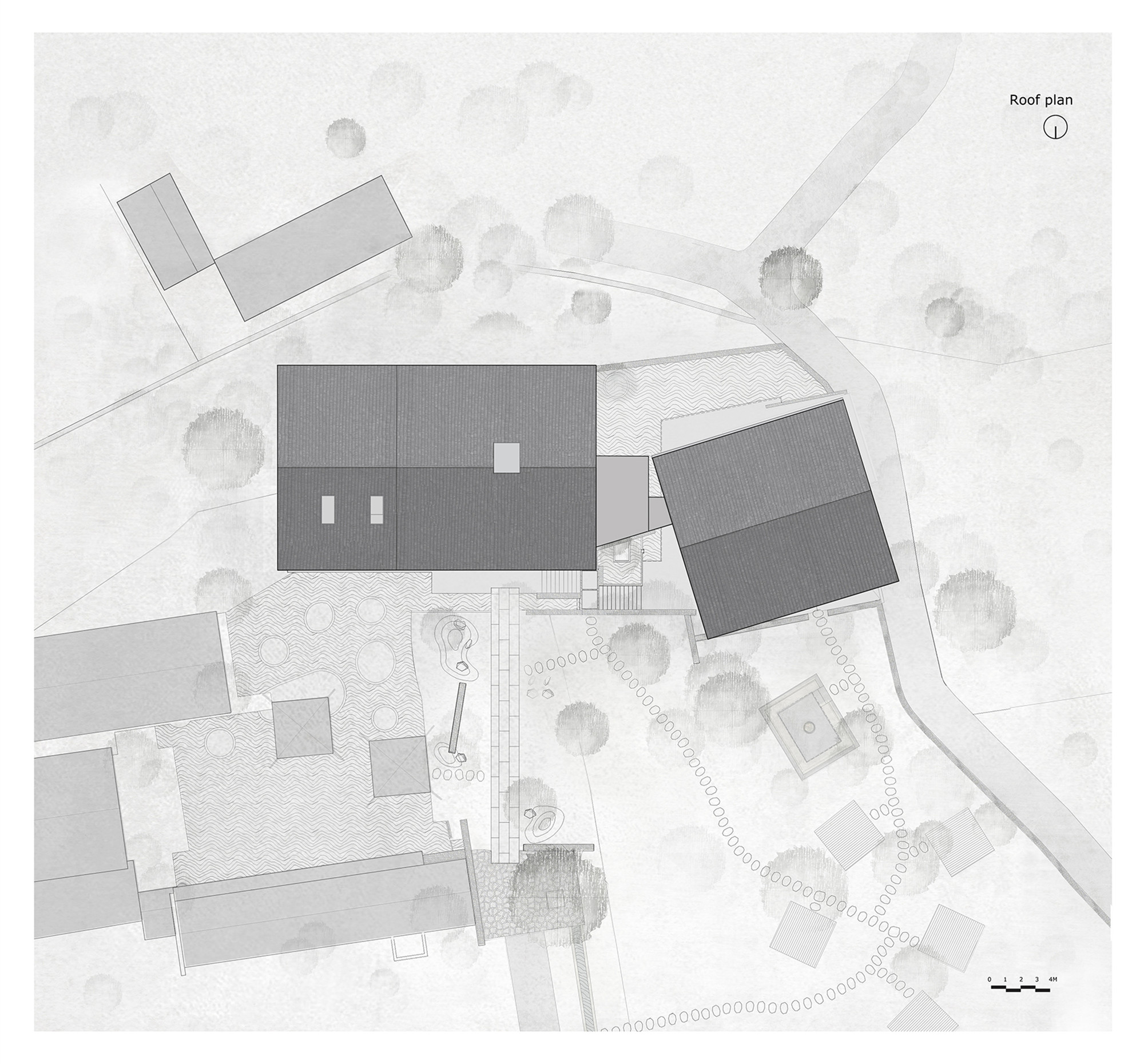
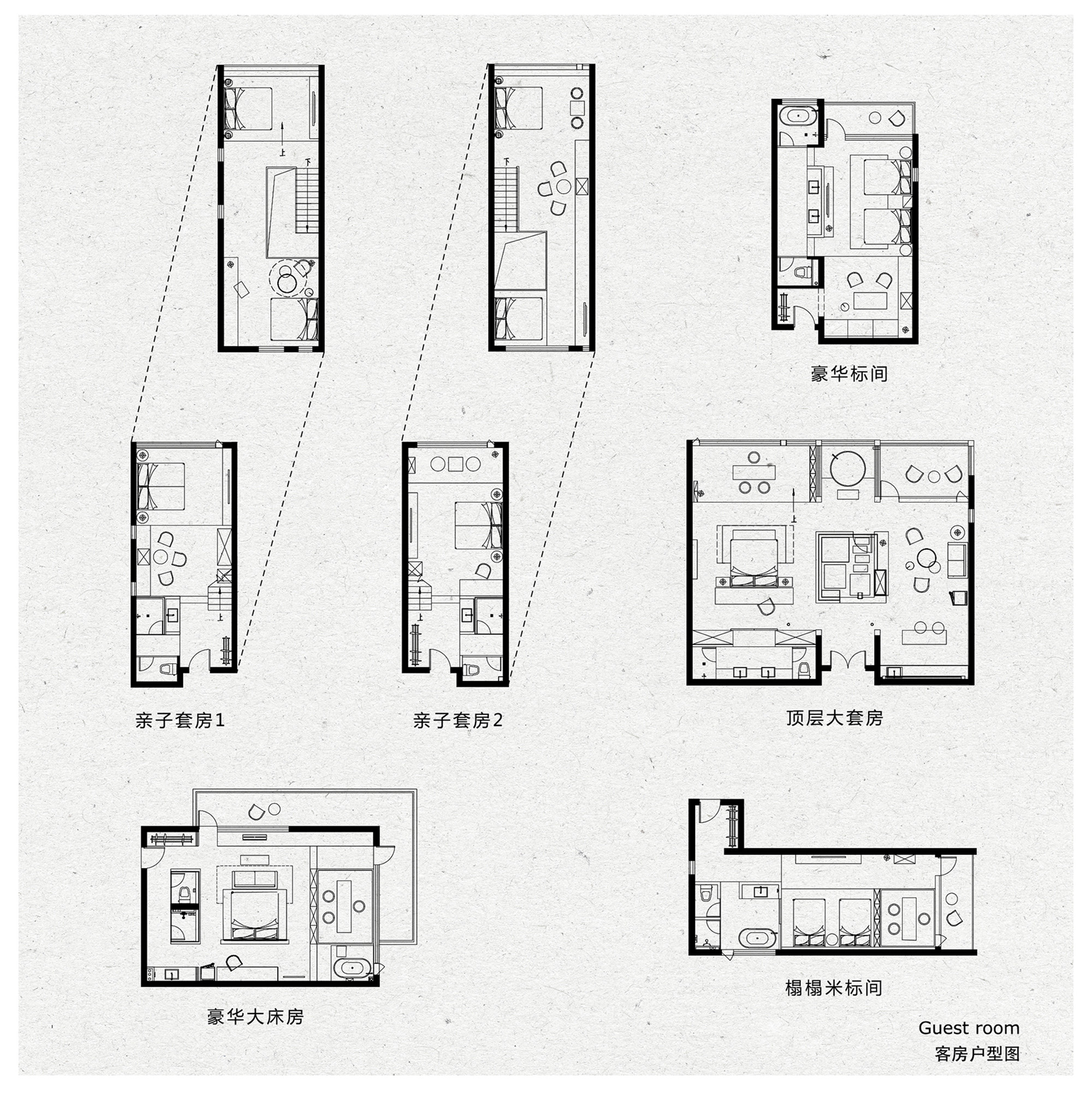
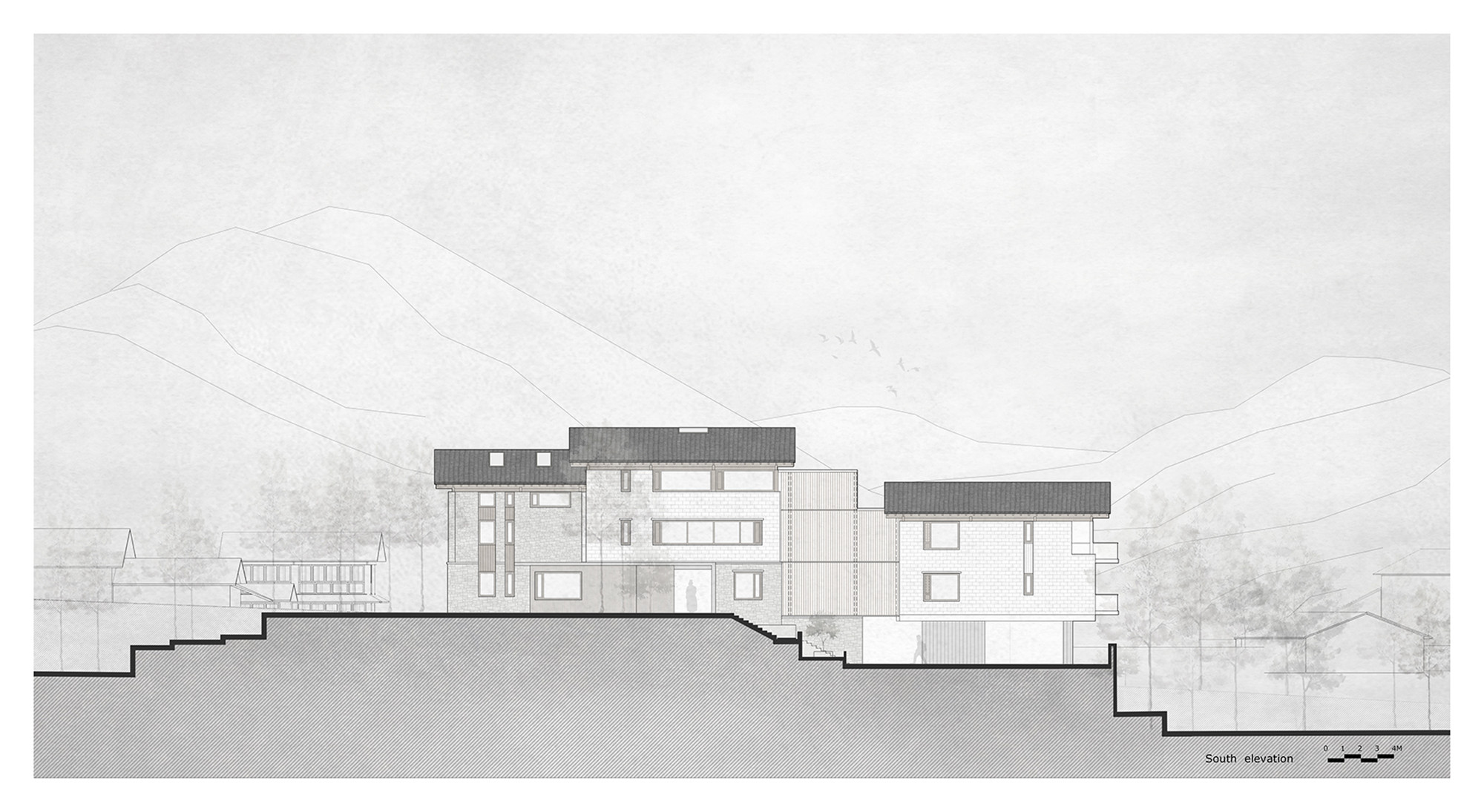
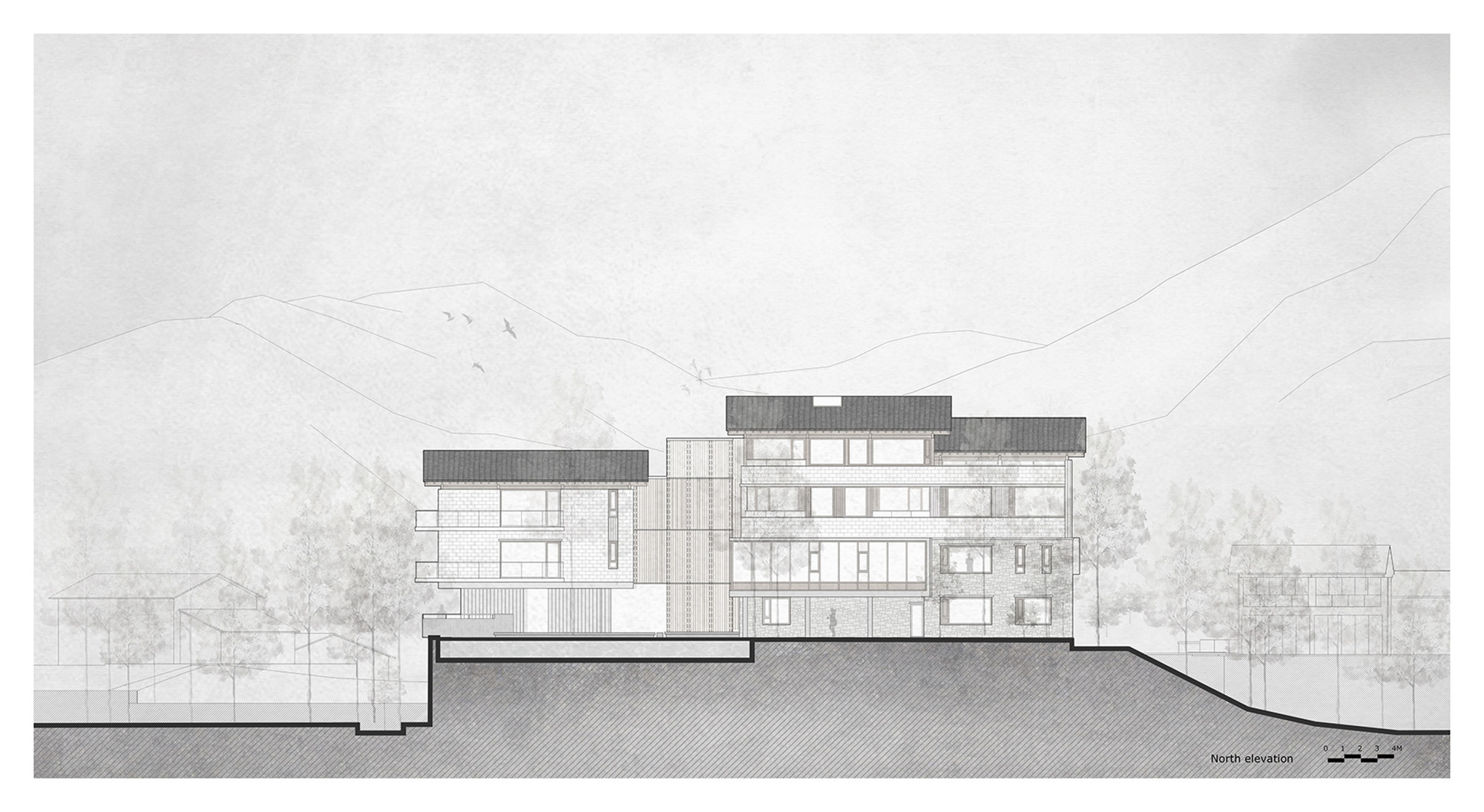

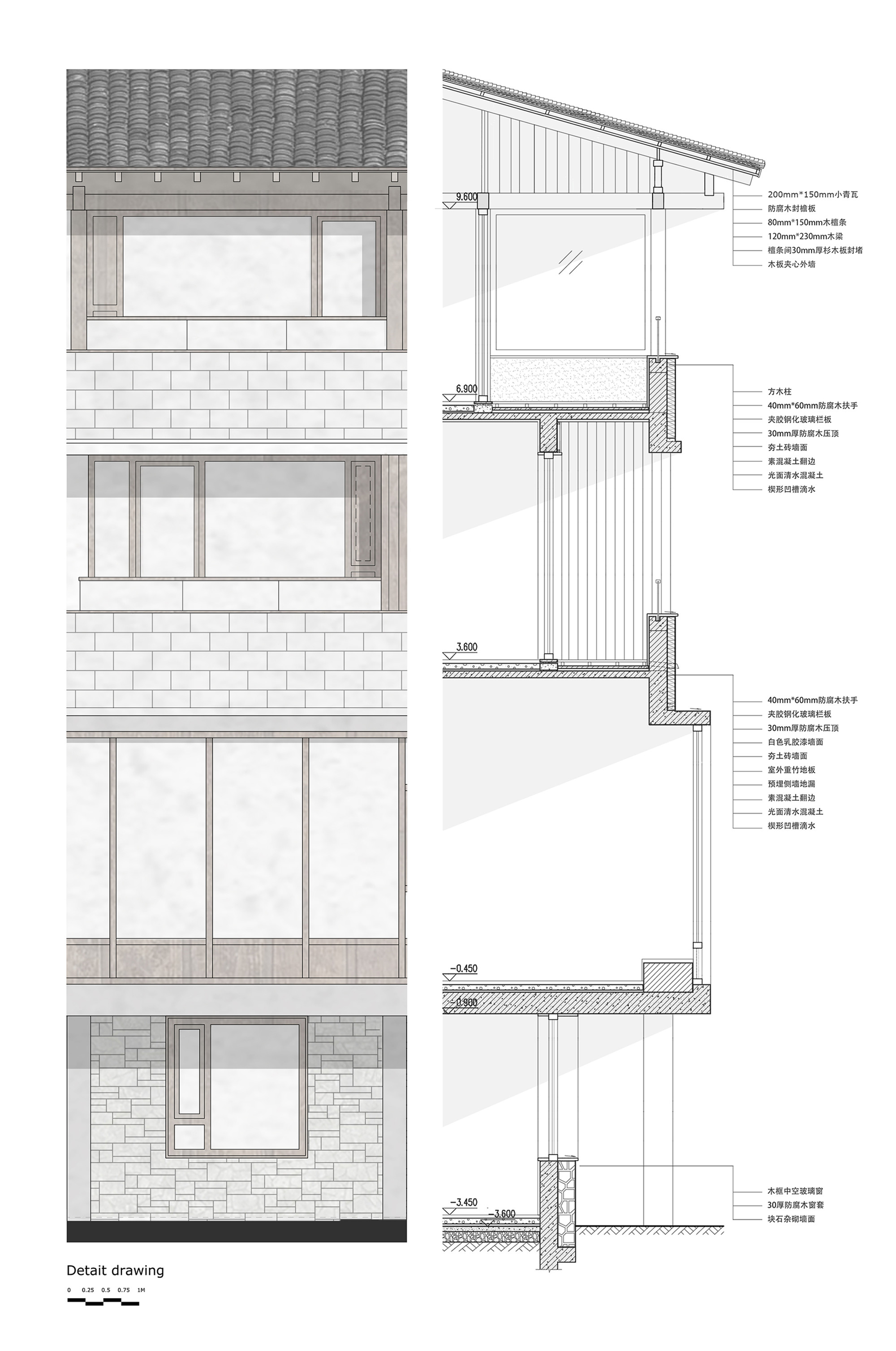
完整项目信息
项目名称:张家界马儿山·林语山房(又名燕儿窝)
项目地点:湖南省张家界市马儿山村
项目业主:张家界美丽乡村旅游开发有限公司
项目类型:文旅民宿酒店
设计时间:2019年2月—2019年6月
建造时间:2019年8月—2020年8月
设计单位:尌林建筑设计事务所
主持建筑师:陈林
建筑设计师:刘东英、时伟权、陈松
室内建筑师:刘东英、时伟权、陈伊妮
软装设计:陈伊妮、时伟权、赵艺炜
品牌设计:虚谷设计
结构设计:高翔
植物设计:物喜·陆辰
家具品牌:屮房
结构形式:混凝土框剪/钢木结构
设计范围:规划、建筑、室内、软装落地、景观、品牌标识、一体化设计
建筑材料:木模混凝土、非洲柚木、毛石墙、青砖、土砖、小青瓦、水磨石、水洗石、合成竹
建筑面积:1200平方米
建筑摄影:赵奕龙、吴昂
文章撰写:陈林
视频剪辑:丁诗颖
版权声明:本文由尌林建筑设计事务所授权发布。欢迎转发,禁止以有方编辑版本转载。
投稿邮箱:media@archiposition.com
上一篇:大别山乡村会客厅:重构工业风貌 / 禾秣设计+合尔建筑
下一篇:以“悬浮”换用地:郑州大学实验小学西校区 / 上海和睿规划建筑设计